
Country profile
June 2022
Early warning assessment related to the 2025 targets
for municipal waste and packaging waste
Spain
Contents
Acknowledgements ................................................................................................................................. 1
1 Introduction ..................................................................................................................................... 2
1.1 Background and purpose ........................................................................................................ 2
1.2 Approach ................................................................................................................................. 2
1.3 Member State profile – context parameters .......................................................................... 3
2 Success and risk factors likely to influence future performance ..................................................... 8
2.1 Target for preparing for reuse and recycling of municipal waste ........................................... 8
2.1.1 Current situation and past trends ....................................................................................... 8
2.1.2 Legal instruments .............................................................................................................. 10
2.1.3 Economic instruments ...................................................................................................... 12
2.1.4 Separate collection system ............................................................................................... 14
2.1.5 Extended producer responsibility (EPR) and similar schemes .......................................... 19
2.1.6 Treatment capacity for bio-waste ..................................................................................... 21
2.2 Target for the recycling of packaging waste ......................................................................... 24
2.2.1 Current situation and past trends ..................................................................................... 24
2.2.2 Legal instruments .............................................................................................................. 28
2.2.3 Economic instruments ...................................................................................................... 29
2.2.4 Separate collection system ............................................................................................... 32
2.2.5 Extended producer responsibility (EPR) and similar schemes .......................................... 35
2.3 Target on landfill of municipal waste .................................................................................... 38
2.3.1 Current situation and past trends ..................................................................................... 38
3 Conclusion ..................................................................................................................................... 40
3.1 Prospects for meeting the recycling target for municipal solid waste ................................. 40
3.2 Prospects for meeting the recycling target for packaging waste ......................................... 41
3.3 Prospects of meeting the landfill of municipal waste target ................................................ 43
List of abbreviations .............................................................................................................................. 44
References ............................................................................................................................................ 45
Annex 1 Implementation of previous early warning recommendations .............................................. 49
Annex 2 Detailed scoring of success and risk factors ........................................................................... 51
1
Acknowledgements
This draft assessment has been prepared by the ETC/WMGE and the successive ETC/CE under
guidance of the European Environment Agency and with inputs from a consortium led by Rambøll
Group under contract with the European Commission. It builds to a large extent on the answers
provided by the Ministry for the Ecological Transition and the Demographic Challenge in March 2021
to a questionnaire developed by the EEA and ETC/WMGE. The EEA and ETC/CE would like to thank the
Spanish authorities for the information provided and for the kind review of drafts of the assessments
in 2021 and April 2022.
2
1 Introduction
1.1 Background and purpose
The Waste Framework Directive 2008/98/EC (as amended by Directive (EU) 2018/851) includes a
target to recycle and prepare for reuse, by 2025, 55 % of municipal waste generated. The Packaging
and Packaging Waste Directive (94/62/EC as amended by Directive (EU) 2018/852) includes targets
for the recycling of packaging waste, both in total and by material, to be achieved by 2025. The Landfill
Directive (1999/31/EC as amended by Directive (EU) 2018/850) requires to limit the landfilling of
municipal waste to 10 % of the generated municipal waste by 2035. The Directives also foresee that
the European Commission, in cooperation with the European Environment Agency, publishes early
warning reports on the Member States’ progress towards the attainment of the targets, including a
list of Member States at risk of not attaining the targets within the respective deadlines, three years
ahead of the target dates. This assessment is a contribution from the EEA to the early warning reports
according to Article 11b Waste Framework Directive and Art. 6b Packaging and Packaging Waste
directive.
This document is an early warning assessment for Spain. The document is based on the analysis of a
number of factors affecting recycling performance (success and risk factors). The assessment aims at
concluding whether Spain is at risk of missing the targets for municipal waste and packaging waste set
in EU legislation for 2025. In addition, it provides a preliminary assessment of the prospects for
meeting the 2035 target for landfilling of municipal waste.
The assessment takes into account information that was available before 10 May 2022.
1.2 Approach
The assessment follows a methodology developed by the EEA and ETC/WMGE and consulted with the
Eionet in 2020 (ETC/WMGE, 2021), which was adjusted in 2021 taking into account experiences with
applying the methodology in 2021 (ETC/CE & ETC/WMGE, 2022). This methodology uses a set of
quantitative and qualitative success and risk factors that have been identified to affect the recycling
performance. The assessment is to a large extent based on the information provided by the Member
State in the reply to an EEA-ETC/WMGE questionnaire as well as on available data and information
from Eurostat and other relevant sources. In addition, a consortium under contract with the European
Commission (led by Rambøll Group) has conducted a critical review of the draft assessment in
Q4/2021 and provided further information.
More specifically, chapter 2.1 assesses the likelihood for Spain to achieve the target to prepare for
reuse and recycle at least 55 % of municipal solid waste (MSW) for 2025. Chapter 2.2 assesses the
likelihood for Spain to achieve the overall packaging waste and specific packaging materials’ recycling
targets for 2025. Chapter 2.3 examines the prospects for Spain to landfill less than 10 % of the
generated municipal solid waste by 2035. The official early warning assessment for the landfilling
target is only due in 2032 and accordingly, the assessment contained in Chapter 2.3 is only preliminary.
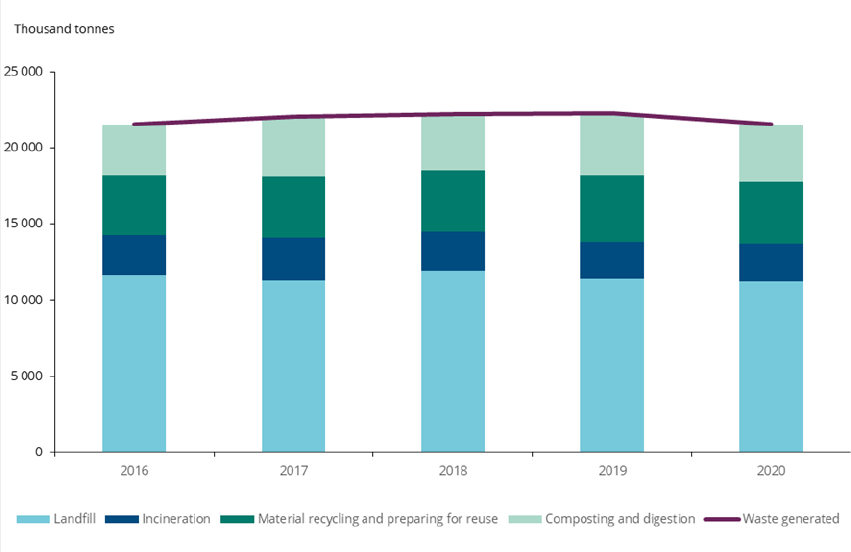
3
1.3 Member State profile – context parameters
Municipal waste generation and treatment
Spain generates around 22 million tonnes of municipal waste annually, and total waste generation has
slowly but steadily increased from 2016 onwards but decreased slightly in 2020 to 21.5 million tonnes
(Figure 1.1). Waste generation corresponded to 455 kg/cap in 2020, below the (estimated) EU average
of 505 kg/cap. The country still relies heavily on landfilling, showing a minor decrease of the landfill
share from 54.1 % to 52.0 % in the period 2016-2020. Nevertheless, the total tonnage of landfilled
waste remained fairly constant over the same period, fluctuating between 11.9 and 11.2 million
tonnes. The amount of waste sent to incineration was also stable, shifting within a range of 2.5 to 2.8
million tonnes annually, and accounting between 11 and 12 % of the total volume of treated waste.
The rate of material recycling and composting/digestion increased from 33.9 % to 36.4 % between
2016 and 2020.
Spain is heavily reliant on mechanical biological treatment (MBT) plants for pre-treatment of the not
separately collected fraction of MSW (residual fraction). This residual fraction consists for about 40 %
of organic materials in Spain. In 2019, of the 143 biological treatment plants in Spain, 88 received
residual MSW, whereas only 55 plants are equipped to treat separately collected biowaste. About 74
% of all MSW that is landfilled in Spain, consists of reject from MBT, packaging sorting, and bio-waste
treatment; the remaining 26 % is residual MSW that is directly landfilled without any pre-treatment
(Ministry for the Ecological Transition and the Demographic Challenge, 2021).
In summary, both waste generation and waste treatment have been rather stable in the period 2016-
2020.
Figure 1.1 Municipal waste generation and treatment in Spain between 2016 and 2020, in thousand
tonnes
Note: Data for 2020 are flagged as estimates.
Source: Eurostat (2022b)
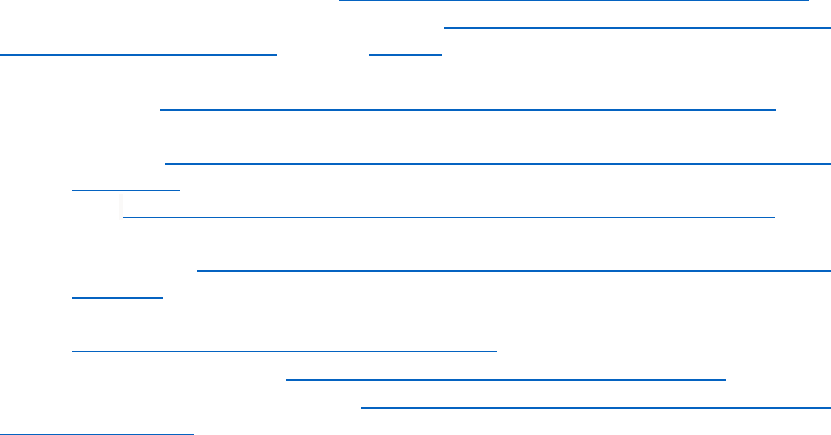
4
Legal Framework
• Directive (EU) 2018/850 of the European Parliament and of the Council of 30 May 2018
amending Directive 1999/31/EC on the landfill of waste has been transposed by Royal Decree
646/2020, of 7 July 2020 (de Miguel and Fernández, 2021).
• On 8 April 2022, the new Law on Waste and Contaminated Soil for a Circular Economy was
published in the Official State Gazette (BOE) (Jefatura del Estado, 2022). The Law implements
the modifications introduced by Directive (EU) 2018/851 of the European Parliament and of
the Council of 30 May 2018, which amended Directive 2008/98/EC on waste as well as the so-
called Directive on single-use plastics, i.e. Directive (EU) 2019/904 of the European Parliament
and the Council of 5 June 2019 on reducing the impact of certain plastic products on the
environment.
• Directive (EU) 2018/852, on packaging and packaging waste, is still in the process of
transposition.
• The Spanish circular economy strategy España Circular 2030 (Ministerio para la Transición
Ecológica y el Reto Demográfico, No date) includes a 15 % reduction target of waste
generation, compared to what was generated in 2010; a target for reducing food waste
generation in the entire food chain: 50 % reduction per capita at the household and retail
consumption level and 20 % in the production and supply chains as compared to 2020; and a
target to increase reuse and preparing for reuse to reach 10 % of municipal waste generated.
Waste management plan(s)
Spain has a National Waste Management Plan 2016-2022, the National Waste Framework Plan
(PEMAR) 2016-2022 (Dirección General de Calidad y Evaluación Ambiental y Medio Natural, 2015), as
well as regional waste management plans.
According to the Spanish authorities, 14 Autonomous Communities and the Autonomous City of Ceuta
have a waste management plan in accordance with the content provided for in Article 28 of Directive
2008/98/EC modified by Directive (EU) 2018/851, and have been notified to the European Commission
in accordance with article 33(1) of Directive 2008/98, and according to the format established in the
Decision (2013/727/EU) establishing a format for notifying the information on the adoption and
substantial revisions of the waste management plans and the waste prevention programmes (MITECO,
2022):
• Andalucía (notified on 14 April 2021): Plan Integral de Residuos de Andalucía (PIREC 2030);
• Principado de Asturias (notified on 6 April 2017): Plan estratégico de residuos del Principado
de Asturias 2017-2024 (PERPA) and their annexes;
• Islas Baleares (notified on 5 August 2020):
o Mallorca: Plan Director Sectorial de Residuos no Peligrosos de la isla de Mallorca 2018-
2030.
o Menorca: Plan Director Sectorial de Prevención y Gestión de Residuos no Peligrosos
de Menorca 2019-2025
o Ibiza: Plan Director Sectorial de Prevención y Gestión de Residuos no Peligrosos 2019-
2023
o Formentera: Plan Director Sectorial de Prevención y Gestión de Residuos no
Peligrosos
o Plan de residuos peligrosos de las Islas Baleares
http://www.caib.es/eboibfront/ca/2020/11151);
• Canarias (pending notification): Plan Integral de Residuos de Canarias 2021-2027;
• Cantabria (notified on 24 July 2017): Plan de Residuos de la Comunidad Autónoma de
Cantabria 2017-2023;

5
• Castilla-La Mancha (notified on 14 April 2021): Plan Integrado de Gestión de Residuos de
Castilla-La Mancha;
• Cataluña (notified on 9 May 2018): Programa de prevención y gestión de residuos 2020
(PRECAT20) and Plan territorial sectorial de infraestructuras de gestión de residuos
municipales de Cataluña 2020 (PINFRECAT20);
• Ceuta (notified on 8 October 2018): Plan de gestión de residuos de Ceuta 2016-2022;
• Comunidad de Madrid (notified on 9 January 2019): Estrategia de Residuos de la Comunidad
de Madrid (2017-2024);
• Comunidad Foral de Navarra (notified on 13 January 12017): Plan de Residuos de Navarra
2017-2027;
• Comunidad Valenciana (notified on 22 March 2021): Plan integral de residuos de la
Comunidad Valenciana (reviewed in 2019);
• Extremadura (notified on 13 January 2017): Plan Integrado de Residuos de Extremadura
(PIREX) 2016-2022 (modified in 2020);
• La Rioja (notified on 5 December 2016): Plan Director de Residuos de La Rioja 2016-2026;
• Murcia (notified on 17 January 2017): Plan de Residuos de la Región de Murcia 2016-2020
(extended and adapted in July 2020 until 31/12/2022);
• País Vasco (notified on 13 December 2021): Plan de prevención y gestión de residuos de
Euskadi 2030.
Three Autonomous Communities plus the Autonomous City of Melilla have waste management plans
in accordance with Article 28 of Directive 2008/98/EC but are in the process of being reviewed or
updated based on Directive (EU) 2018/851:
• Aragón (approval of the revised plan is expected in the first quarter of 2022);
• Castilla y León (approval of the revised plan is expected in the first quarter of 2022);
• Galicia (approval of the revised plan is expected in the first quarter of 2022);
• Melilla (approval of the revised plan is expected in 2022).
As an example for the content of the regional waste management plans, information for Andalucía,
Comunidad Valenciana and Castilla-La Mancha is given below:
• Andalusia: The Regional Waste Management Plan (RWMP) Comprehensive Waste Plan
Andalusia. Towards a Circular Economy in the 2030 Horizon (Junta de Andalucía, 2021) has
been approved by the Regional Ministry for Agriculture, Livestock, Fishing and Sustainable
Development on 6 April 2021. The Plan states that in accordance with the provisions of Section
5 of Article 14 of Law 22/2011, of 28 July, on waste and contaminated soils, the plan will be
evaluated and reviewed no later than six years after its entry into force, without prejudice of
the updates and specific modifications that are deemed appropriate as a result of deviations
in the objectives, regulatory changes or the need to adapt to technical progress. The regional
WMP covers all waste streams with dedicated chapters covering targeted waste streams.
• Valencia: The Review and Adaptation of the Comprehensive Waste Plan of the Valencian
Community was approved by the Decree 55/2019, of 5 April, that approves the revision of the
Comprehensive Waste Plan of the Valencian Community (DOGV No. 8536, of April 26, 2019)
(Consellería de Agricultura, Medio Ambiente, Cambio Climático y Desarrollo Rural, 2019).
• Castilla-La Mancha: The Regional Waste Management Plan (RWMP) Integrated Waste
Management Plan for Castilla-La Mancha (Plan Integrado de Gestión de Residuos de Castilla-
La Mancha, 2016) has been approved with a decree of the Directorate General for the Circular
Economy of the Regional Ministry for Sustainable Development on 23 March 2021. The
application period is 2016-2022. The Plan was approved in 2016 and runs until 2022. As
established in section 2 of the Plan, its evaluation and review will be carried out after six years,
i.e. in 2022. Work is currently underway on the evaluation for the revision of the Plan.
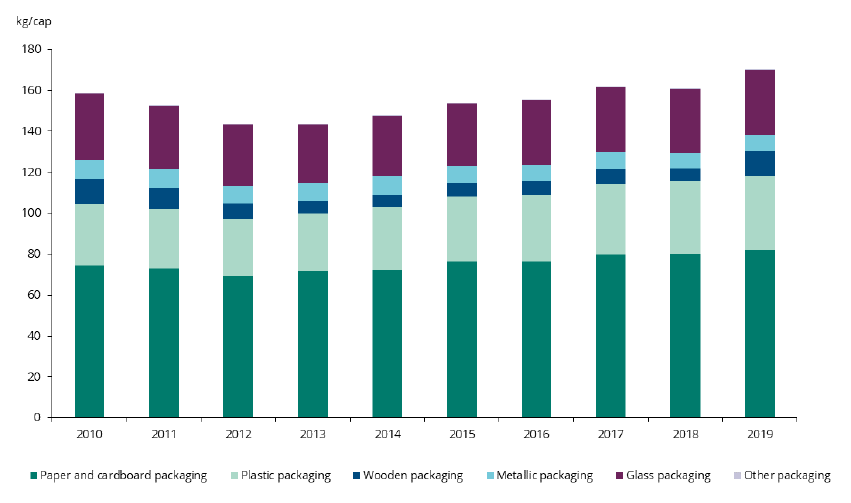
6
Implementation of previous early warning recommendations
Spain had been considered being at risk of missing the 2020 target of 50 % preparation for re-use /
recycling for municipal waste by the European Commission (EC, 2018b), and it received a set of policy
recommendations (EC, 2018a). Annex 1 lists the recommendations and a self-assessment of the
Spanish authorities on the status of taking them into account.
Packaging waste generation and treatment
In Spain, more than 8 million tonnes (170 kg/cap) of packaging waste were generated in 2019, slightly
below the EU average of 177 kg/cap. After hitting a low during 2012 and 2013, the total weight of
packaging waste generation per capita in 2018 reached the same level as in 2010, but with a shift from
wooden packaging towards plastic and paper and cardboard packaging (Figure 1.2). In 2019, a new
all-time high was reached for the amount of packaging waste generated.
Figure 1.2 Packaging waste generation in Spain between 2010 and 2019, in kg per capita
Source: Eurostat (2022c)
Capture rate for recyclables
The capture rate is a good performance indicator of the effectiveness of the separate collection
system. The capture rate is calculated by dividing the separately collected weight of a certain material
for recycling by the weight of the material in total municipal waste. The residual MSW composition
that was used for calculating the contribution of a specific material group to the total MSW volume is
from 2010 and thus might not represent the current composition any more, but more recent data is
not available. Data on the volumes of separately collected material streams were provided by the
Spanish authorities (MITECO, nd). It is important to note that these data do not differentiate between
households and non-household sources. Data on the separate collection of the individual packaging
material fractions of metals and plastic were obtained from Ecoembes (2021). Capture rates in Spain,
as shown in Table 1.1, vary between 49 % for glass, and 4 % for textiles, evidencing an important
potential for improving the separate collection rates.

7
Table 1.1 Capture rates for different waste fractions in Spain
Residual
waste
composition
(%)(
b
)
Residual
waste
composition
(tonnes)(
a
)
Separately
collected
amounts
(tonnes)(
b
)
Materials in
total MSW
(tonnes)
Capture
rates (%)
Reference year
2010
2018
2018
Mixed municipal waste, total
17 646 563
Paper and cardboard
14 %
2 444 049
1 067 384
3 511 433
30 %
Metals
3 %
603 512
260 023
863 535
30 %
Glass
5 %
873 505
834 764
1 708 269
49 %
Plastic
13 %
2 248 172
571 910
2 820 082
20 %
Bio-waste
47 %
8 323 884
1 005 679
9 329 563
11 %
Textiles
5 %
968 796
40 344
1 009 140
4 %
Wood
2 %
356 461
136 153
492 614
28 %
(
a
) Note: Share of material in residual waste (household waste only) multiplied with the amount
of residual waste in 2018 as reported in the questionnaire by the Ministry for the
Ecological Transition and the Demographic Challenge (2021)
(
b
) Source: As reported in the EEA-ETC/WMGE questionnaire by the Ministry for the Ecological
Transition and the Demographic Challenge (2021); MITECO (nd); Ecoembes (2021).
8
2 Success and risk factors likely to influence
future performance
2.1 Target for preparing for reuse and recycling of municipal waste
This chapter aims at assessing the prospects of Spain to achieve the 55 % preparing for reuse and
recycling target for municipal waste in 2025. For a detailed description of the methodology followed,
the development of success/risk factors and their impact on recycling, please consult the methodology
report (ETC/CE & ETC/WMGE, 2022).
2.1.1 Current situation and past trends
SRF MSWR-1.1: Distance to target
The overall recycling rate of Spain shows that the distance to target is 18.6 percentage points (Figure
2.1). In this analysis the recycling rate is calculated by dividing the summed amounts of recycling of
materials and of composting and digestion by the total generated amounts. The data source used is
the Eurostat data set Municipal waste by waste management operations [env_wasmun] (following the
OECD/Eurostat Joint Questionnaire); Data reported by Member States according to Article 10.2(a) of
the Waste Framework Directive are not used for this assessment as the reporting methods differ by
Member State, resulting in a lack of comparability between Member States. The data source used
here is assumed to be the best available proxy, given that data in accordance with the rules on the
calculation of the attainment of the targets as defined in Article 11a are not yet available.
In Spain the organic material resulting from the treatment of residual MSW in MBT installations is
rightly not considered as compost, but is referred to as bio-stabilized material (Gallardo, 2014). In
2019, 8.9 million tons of MSW treated in so-called composting MBT, resulted in about one million
tonnes of bio-stabilized material (MITECO, nd). The amounts reported as ‘composted or digested’
include outputs (bio-stabilized material) from MBT plants treating mixed municipal waste (Eurostat,
2017). In 2019, about 1.1 million tonnes of bio-waste was collected separately in Spain (Ministry for
the Ecological Transition and the Demographic Challenge, 2021). If only these amounts are counted
as recycled, the recycling rate would drop to 20 %. From 2027, the biostabilized MBT outputs will not
be allowed to be counted as recycled waste according to the Waste Framework Directive, resulting in
an urgent need to move to separate collection of bio-waste in Spain.
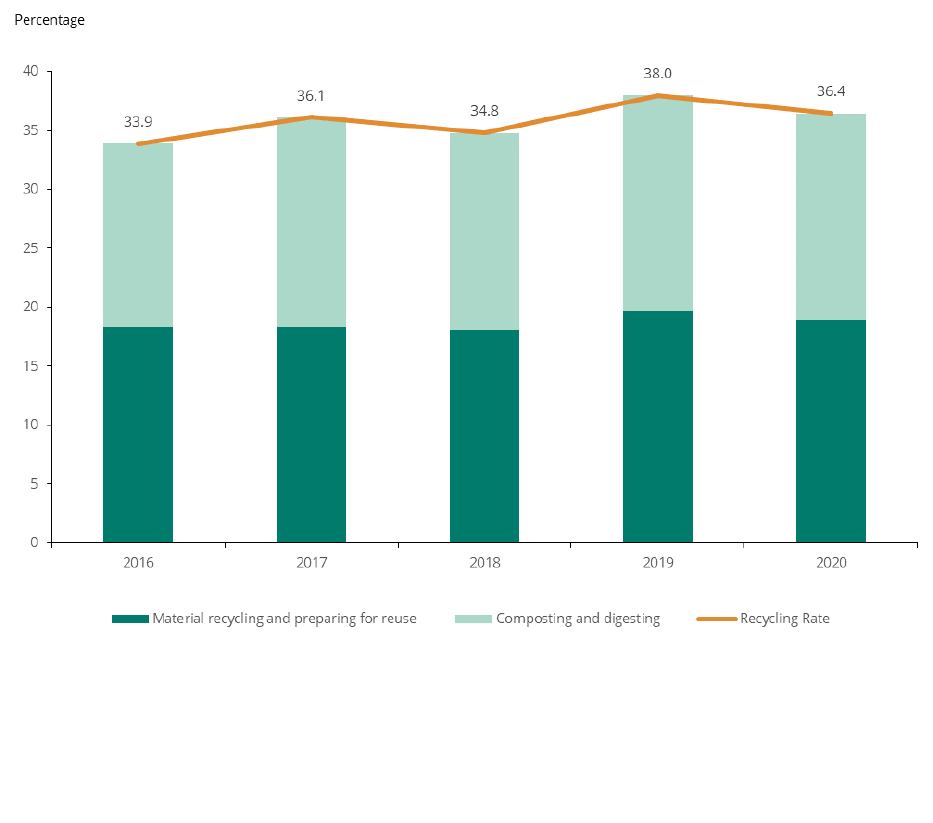
9
Figure 2.1 Recycling rate in Spain between 2016 and 2020, in percentage
Note: Data for 2020 are flagged as Eurostat estimates.
Source: Eurostat (2022b)
The actual distance to the target for the most recent data point is a key factor determining the
likelihood of meeting/not meeting the target. The closer the Member State is to the target already,
the more likely it becomes that the target will be met. For Spain, the recycling rate is 36.4 % in 2020
(Figure 2.1), which is 18.6 percentage points below the target. When using 2019 data as basis for the
assessment given that 2020 data is still an estimate, the recycling rate was 38.0 %, 17 percentage
points below the target.
However, the data used for this analysis are based on a different methodology than the calculation
rules for the target. A study of the impact of the new calculation rules has not been carried out in
Spain. A few Member States have provided quantified estimates indicating how the application of the
new reporting rules would influence the recycling rate (compared to the data reported to Eurostat
under the Joint Eurostat/OECD questionnaire), resulting in reductions between 3.8 and 13 percentage
points, and on average 5.5-6.7 percentage points. In the case of Spain, both composting and recycling
figures do however not account for discarded waste resulting from their respective operations.
Instead, these discarded waste amounts have been added to landfilling and incineration figures
(Eurostat, 2017). While the effect of the new calculation rules depends on how Spain currently reports
the data, an effect of a reduction with 5 percentage points is assumed for this assessment, bringing
the recycling rate down to 31.4 % in 2020 (33 % in 2019). However, this assumption will not result in
a change of the assessment for this SRF.

10
Summary result
Distance to target
> 15 percentage points
Based on currently available data Spain’s recycling rate was 36.4 %, 18.6
percentage points below the 2025 target. Considering however the impact of
the new calculation rules, we assume a reduction with 5 percentage points for
this assessment, resulting in an estimated recycling rate of 31.4 %, 23.6
percentage points below the target. If 2019 data is used for the assessment,
given that the 2020 data is still an estimate, the distance to the target would
be 22 percentage points.
Robustness of the underlying
information
The currently available data do not yet reflect the calculation rules applicable
to the target. Spain has not yet quantified the influence of the new calculation
rules on the recycling rate (at the time of writing this assessment). However,
also a recycling rate which would be 5 percentage points below the currently
reported, would not change the assessment for this SRF.
SRF MSWR-1.2: Past trend in municipal solid waste recycling rate
For Spain, the recycling rate over the last five years shows very modest improvements. The recycling
rate is 36.4 % in 2020, which is 2.6 percentage points higher as compared to 2016, reflecting an
average yearly improvement of 0.6 percentage points. Especially, the variation over the years of the
contribution of digestion and composting is considerable, accounting for between 15.6 and 18.3 % of
the total generated waste (Figure 2.1).
Meeting the target will thus require an annual increase of 3.7 percentage points annually in the period
2020-2025, demanding a significant improvement of the pace compared to the average yearly
improvement in the previous 5-year period.
Summary result
RR < 45% and increase in last 5
years < 10 percentage points
The recycling rate has increased by 2.6 percentage points over the past five
years. For Spain, the application of the new calculation rules would indicate an
estimated recycling rate of 31.4 % in 2020.
Robustness of the underlying
information
There are no breaks in the time series data. The currently available data does
not yet reflect the calculation rules applicable to the target. The Ministry for
the Ecological Transition and the Demographic Challenge is developing a
national register, where complete information about waste generation,
treatment and disposal will be compiled. Treatment capacities and efficiency
will be among the information required from the treatment plants.
2.1.2 Legal instruments
SRF MSWR-2.1: Timely transposition of the revised Waste Framework Directive into national law
Timely transposition of the Waste Framework Directive, as amended by Directive 2018/851, into
national law within the foreseen period is key for a waste management system in line with EU
requirements.
Spain has transposed the amended Waste Framework Directive into national law, more than one year
after the deadline of 5 July 2020. In April 2022, the new Law on Waste and Contaminated Soil for a
Circular Economy came into force (Jefatura del Estado, 2022).

11
Summary result
Transposition with delay of > 12
months
The transposition has been delayed by more than 12 months
Robustness of the underlying
information
The new Law on Waste and Contaminated Soil for a Circular Economy
(Ley 7/2022) was published in the Official State Gazette (Jefatura del
Estado, 2022).
SRF MSWR-2.2: Responsibilities for meeting the targets, and support and enforcement mechanisms, e.g.
tools, fines etc.
Clearly defined responsibilities, enforcement and support mechanisms for meeting the targets across
different entities and governance levels are important for achieving high recycling rates. The clearer
the responsibilities for meeting the targets and accountability for failing the targets are, the higher
the chance that the targets will be met.
In Spain, the competences on waste management mainly fall on the regional authorities
(Comunidades Autónomas). Waste collection and treatment systems are designed and operated
locally, either by single municipalities or groups of them (e.g. mancomunidades, diputaciones, etc.).
The State Waste Management Framework Plan 2016-2022 (PEMAR) indicates the structure and
contents of the regional waste management plans, and has extended the responsibility of achieving
the recycling targets to the Autonomous Communities. However, a lack of enforcement instruments
at national level appears to limit the capacity of national authorities to enforce this requirement.
Moreover, even when the PEMAR establishes minimum contents for the Regional Waste Management
Plans, these contents are perceived as too general and do not necessarily ensure the accomplishment
of targets at regional level (Eunomia, 2018).
According to the Ministry for the Ecological Transition and the Demographic Challenge, national
authorities mainly have a coordinating role and provide the legislative framework at national level.
The new Law on Waste and Contaminated Soil for a Circular Economy introduces national landfill and
incineration taxes, in replacement of the taxes established by some regional authorities. Regarding
the consequences if the competent regional authorities do not take enough or ineffective actions,
currently, the only existing mechanism is the infringement procedure of the European Union. Although
the sanctions are imposed on Spain as a Member State, the Royal Decree 515/2013, of 5 July, regulates
the allocation of European sanctions to the subnational authorities (‘Comunidades Autónomas’,
‘Comunidad foral’, ‘Entidades Locales’, including the ‘Diputaciones forales’, ‘Ciudades con Estatuto de
Autonomía’) that are responsible for the non-compliance (Eunomia Research & Consulting Ltd, 2018).
Under the previous Law on Waste 22/2011, a gap was still identified between the regional and the
local levels, since the specific contribution of local authorities for the accomplishment of the WFD has
not been defined. Article 26 of the new Law 7/2022 (Jefatura del Estado, 2022) however explicitly
considers the possibility for regional authorities (autonomous communities) to determine the
contribution that local entities must make to meet the targets, either individually or associated with
other entities. In addition, an infraction was introduced in case of not implementing mandatory
separate collection. Furthermore, a maximum percentage was set for non-targeted materials in
separately collected biowaste, of 20 % from 2022 and 15 % from 2027, and the possibility was opened
for establishing maximum impurity levels for other waste fractions too.
The Ministry for the Ecological Transition and the Demographic Challenge (MITECO) has indicated
(Ministry for the Ecological Transition and the Demographic Challenge, 2021) that there is a body for
technical cooperation and collaboration between public authorities, the Commission of Coordination
on Waste, that allows the exchange of information, and facilitates the adoption of measures by public
authorities in order to comply with waste regulations in force. The specific roles and responsibilities
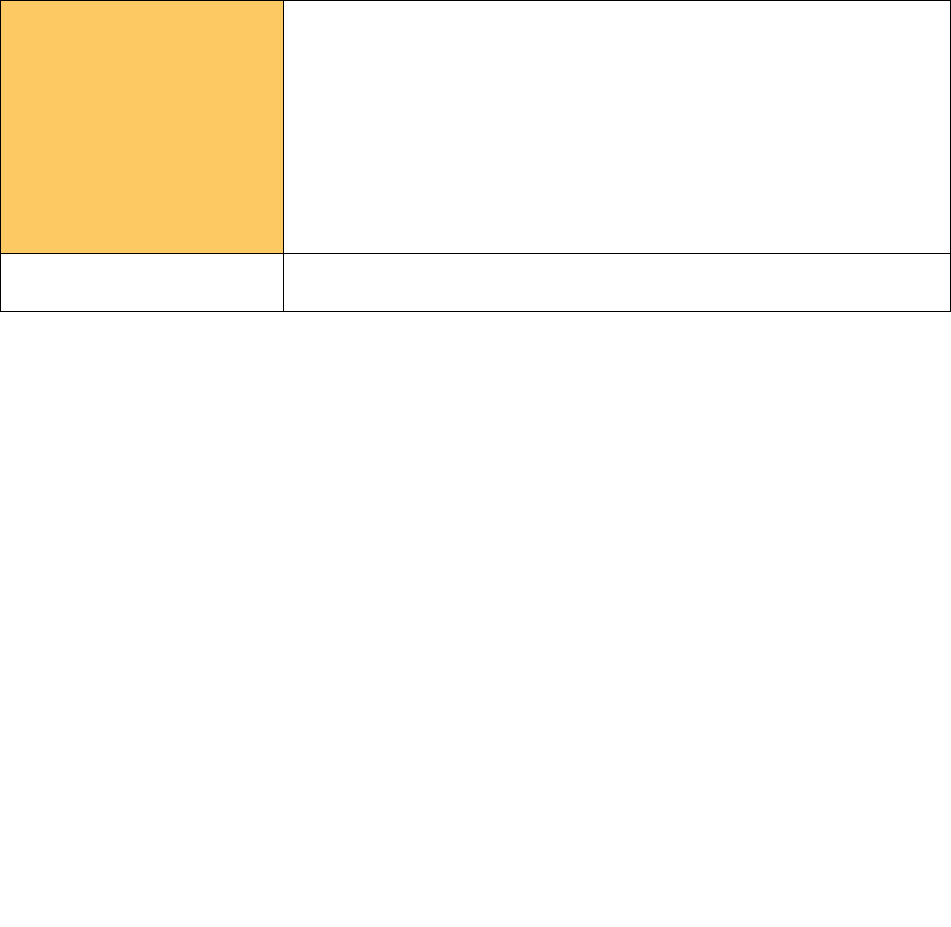
12
of the Coordination Commission on Waste are clearly defined in the new Law. The Coordination
Commission on waste will be chaired by the General Directorate for Quality and Environmental
Assessment and the vice-presidency will be exercised by one of the representative members of the
autonomous communities. By ministerial order, the 30 members that will make up the Commission
will be appointed, including one member designated by each of the autonomous communities, one
member designated by each of the cities of Ceuta and Melilla, three members of the local entities
designated by the State-wide association with the greatest presence and eight members representing
the ministerial departments or bodies attached to them (Boletín Oficial de las Cortes Generales,
Senado, 2022).
Additionally, Spain has been granted funding for an initiative that supports the implementation of
improved recycling collection and treatment systems at the municipal level, through the EU’s
Technical Support Instrument (TSI).
Summary result
Clearly defined responsibilities
and good set of support tools
but weak/no enforcement
mechanisms for meeting the
recycling targets
Clearly delimited responsibilities and the introduction of enforcement
mechanisms regarding waste management and extended producer
responsibility, as well as the introduction or modification of economic
instruments, are contained in the new Law on Waste and Contaminated Soil for
a Circular Economy. The Law addresses the gap between regional and local level
authorities with respect to the specific contributions to the accomplishment of
waste management objectives, by opening the possibility for autonomous
communities to determine the contribution that local entities must make for
meeting the targets, either individually or associated with other entities.
Support mechanisms are in place.
Robustness of the underlying
information
Credible information received from the Spanish authorities through the EEA-
ETC/WMGE questionnaire.
2.1.3 Economic instruments
SRF MSW-3.1: Taxes and/or ban for landfilling residual- or biodegradable waste
Bans and taxes on landfilling of residual municipal waste can help to discourage strong reliance on
residual waste treatment and thus support recycling.
The new Law on Waste and Contaminated Soils introduces a national landfill tax, in replacement of
the taxes established by some of the regional authorities. The tax set at the national level establishes
the minimum baseline, regional authorities (autonomous communities) can opt to increase this landfill
tax in their respective regions. The tax distinguishes municipal solid waste (MSW) (40 EUR/t) and reject
from treatment of MSW (30 EUR/t). In Spain, the rejects from mechanical biological treatment (MBT)
plants represent about 65 % – 75 % of the volume of the initial MSW (Esteban-Altabella et al., 2020).
No escalator mechanisms are included −nor foreseen to be included− on the national level.
In general, the landfilling of waste without prior treatment is banned, and there is an express
prohibition of the landfilling of separately collected waste and of unsold surpluses of non-perishable
products such as textiles, toys or electrical appliances. However, the ban is not fully implemented as
a considerable amount of untreated municipal waste is still landfilled. The national landfill tax
introduced in the new Law on Waste and Contaminated Soil for a Circular Economy intends to
discourage this practice. Nevertheless, it remains unclear how a tax can be established on an activity
that is not permitted by law.

13
In addition, a Ministerial Order is expected to pass before 1 January 2023, containing a list of waste
that cannot be landfilled, which will include, among others, the prohibition of the direct landfilling of
municipal waste that is suitable for preparation for reuse, recycling or other recovery.
Summary result
Yes, taxes > 30 EUR/t(
a
)
Minimum tax rates contained in the new Law on Waste and Contaminated Soil
for a Circular Economy:
• MSW Landfill tax: 40 EUR/t (corresponding to 41.9 EUR/t rescaled
based on purchasing power parities)
• Tax for rejects from pre-treatment: 30 EUR/t (corresponding to 31.4
EUR/t rescaled based on purchasing power parities)
No escalators are included on the national level.
Robustness of the underlying
information
The tax rates are contained in the approved text of the new Law on Waste and
Contaminated Soil for a Circular Economy.
(
a
) Note: Rescaled based on purchasing power parities Eurostat (2020a)
SRF MSWR-3.2: Taxes on municipal waste incineration
Taxes on incineration of residual municipal waste can help to discourage strong reliance on residual
waste treatment and thus support recycling.
The new Law on Waste and Contaminated Soils introduces a tax on incineration at national level, in
replacement of the taxes currently established by the regional authorities. Regional authorities
(autonomous communities) can increase this national landfill tax in their respective region. On the
national level, no escalator is included nor foreseen to be included.
A Ministerial Order will establish a list of waste that can be prepared for reuse or recycling and that
cannot be destined for incineration. Incineration, with or without energy recovery, and landfilling of
separately collected waste for preparation for reuse and recycling are prohibited (Boletín Oficial de
las Cortes Generales, Senado, 2022).
Summary result
Yes, taxes > 7 EUR/t(
a
)
• MSW incineration facilities coded as D10: MSW 20 EUR/t and reject
MSW 15 EUR/t (corresponding to respectively 20.9 EUR/t and 15.7
EUR/t rescaled based on purchasing power parities)
• MSW incineration facilities coded as R01: MSW 15 EUR/t and reject
MSW 10 EUR/t (corresponding to respectively 15.7 EUR/t and 10.5
EUR/t rescaled based on purchasing power parities)
• Other incineration facilities: MSW 20 EUR/t and reject MSW 15 EUR/t
(corresponding to respectively 20.9 EUR/t and 15.7 EUR/t rescaled
based on purchasing power parities)
No escalator is foreseen on the national level.
Robustness of the underlying
information
The tax rates are contained in the approved text of the new Law on Waste and
Contaminated Soil for a Circular Economy.
(
a
) Note: Rescaled based on purchasing power parities Eurostat (2020a)
SRF MSWR-3.3: Pay-as-you-throw (PAYT) system in place
PAYT systems are designed to incentivize citizens to make a bigger effort in separating their waste at
source. However, a PAYT system should be designed with the appropriate level of source separation
encouragement to ensure that citizens do not misplace waste in recycling bins in order to avoid

14
residual waste charges. Overall, PAYT usually has a positive effect on source separation and thus
recycling rates through direct involvement of citizens.
PAYT schemes are still scarcely applied by municipalities in Spain. In 2018, 16 municipalities out of
almost 9 000 municipalities in Spain were found to have PAYT schemes in place. Moreover, the existing
PAYT in Spain are volume-based, and there are no weight-based schemes (European Commission,
2019). These can be characterised as a weak PAYT scheme as the economic incentive to sort waste at
source is not very visible to citizens compared to weight-based or sack-based schemes. The Spanish
authorities (Ministry for the Ecological Transition and the Demographic Challenge, 2021) indicated
that the draft version of the proposed Law on Waste would introduce some provisions aimed at
advancing the implementation of PAYT systems, however, apart from a generic reference to the PAYT
principle in article 11, and a mentioning of PAYT systems as an exemplary practice in Annex V, no such
provisions were identified. As a preliminary step to the implementation of PAYT schemes, art. 11.3 of
the new Law on Waste states that local authorities will have to introduce, on a mandatory basis, a
specific and differentiated fee that reflects the real cost of municipal waste management .
Summary result
Less than 50% of the population
covered by PAYT
Far less than 50 % of the population is covered by PAYT schemes. The latest
information available indicates 16 out of 9 000 municipalities had such schemes
in place.
Robustness of the underlying
information
No quantitative data on PAYT are available.
2.1.4 Separate collection system
SRF MSWR-4.1: Convenience and coverage of separate collection systems for the different household
waste fractions
Separate collection systems are a key enabler for high recycling rates and for collecting recyclables at
adequate quality. Generally, the more convenient and accessible these systems are for their users,
the better results they deliver. The assessment methodology categorises different types of collection
systems (door-to-door, bring points with a density of > 5 per km
2
, bring points with a density of < 5
per km
2
, civic amenity site) for assessing the degree of convenience, and differentiates between cities
(densely populated), towns and suburbs (intermediate densely populated) and rural (thinly populated
areas). It then calculates which share of the population is served by which type of system. The
assessment is done on a material basis and takes into account the different materials according to
their average share in municipal waste. This is described in more detail in the methodology (ETC/CE &
ETC/WMGE, 2022).
For Spain, according to the most recent data, the percentage of households living in cities is 51 %, in
towns and suburbs 24 %, and in rural areas 25 % (Eurostat, 2021a).
The new Law on Waste 7/2022 determines in Article 25 which municipal waste fractions are subject
to mandatory separate collection. These fractions are:
• paper, metal, plastic, and glass;
• bio-waste from households before 30 June 2022 for local entities with a legal population of
more than 5 000 inhabitants, and before 31 December 2023 for the rest. Separate collection
of bio-waste will also be understood as the separation and recycling at source through
domestic or community composting;
• textile waste before 31 December 2024;
15
• cooking oils used before 31 December 2024;
• household hazardous waste before 31 December 2024, to ensure that they do not
contaminate other waste streams of local competence;
• bulky waste (furniture and fixtures waste) before 31 December 2024; and
• other waste fractions determined by regulation.
The collection systems used for paper do not distinguish between packaging, waste paper and non-
packaging waste paper. No information was made available on separate collection systems for flat
glass and for non-packaging metals and plastics. The implementation of separate collection systems is
the responsibility of the local authorities. Due to the great variety of circumstances and needs among
municipalities, there are different systems in place. However, the most widespread system provides
separate collection using four different waste bins (lightweight packaging, glass packaging, paper and
cardboard and mixed residual waste). Some Autonomous Communities and municipalities have
already introduced a fifth bin for the separate collection of bio-waste, sometimes making source
separation of bio-waste mandatory. The latter is reported to be the case in Cataluña, Navarra and
certain territories in other regions. The fraction of lightweight packaging includes metal (both steel
and aluminium), plastic and composite packaging. This system is usually complemented with a
network of civic amenity sites that allow the separate collection of other waste streams such as WEEE,
bulky waste or textiles. In addition, WEEE is also collected through take-back systems (reverse
logistics) at retailers.
Table 2.1 gives an overview of the collection system in Spain.
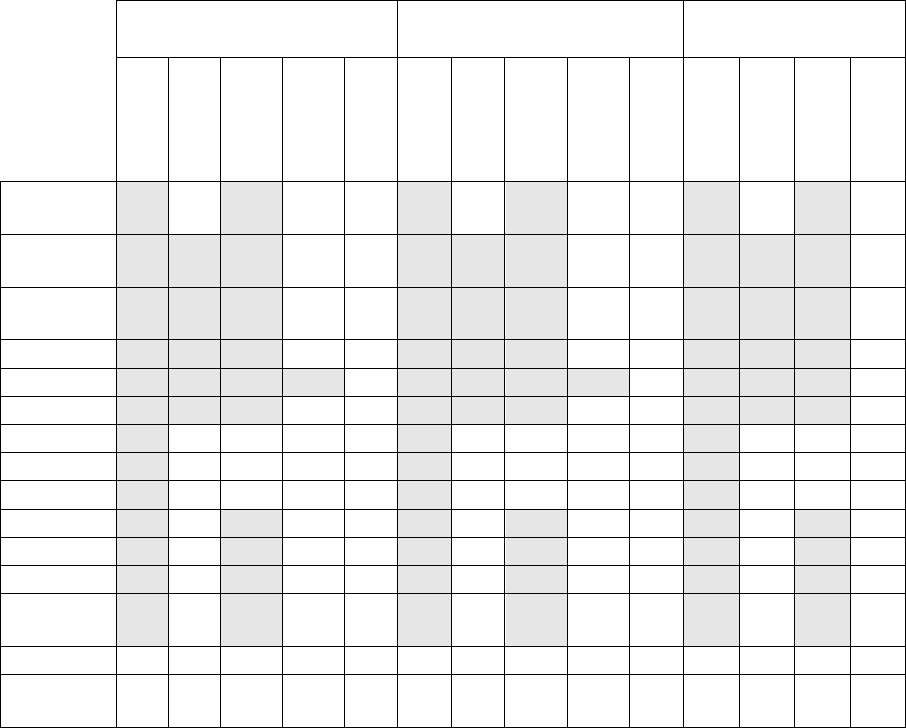
16
Table 2.1 Characterisation of the collection system in Spain
Cities
(densely populated areas)
Towns and suburbs
(intermediate density areas)
Rural areas
(thinly populated areas)
Door-to-door -
separate
Door-to-door -
co-mingled
Bring point
(>5 per km²)
Bring point
(<5 per km²)
Civic amenity
site
Door-to-door -
separate
Door-to-door -
co-mingled
Bring point
(>5 per km²)
Bring point
(<5 per km²)
Civic amenity
site
Door-to-door -
separate
Door-to-door -
co-mingled
Bring point
Civic amenity
site
Residual
waste
xx
x
x
x
x
Paper and
Cardboard
xx
x
x
x
x
Ferrous
metals
xx
x
x
x
x
Aluminium
xx
x
x
x
x
Glass
xx
x
x
x
x
Plastic
xx
x
x
x
x
Bio-waste
xx
x
x
Food
x
x
Garden
x
x
Textiles
x
xx
x
x
Wood
xx
x
x
WEEE
xx
x
x
Composite
packaging
xx
x
x
x
x
Bulky waste
xx
xx
x
x
x
x
Used
cooking oil
x
x
x
x
x
x
Note: xx: dominant system; x: other significant systems. Grey cells indicate high convenience
collection systems.
Source: Ministry for the Ecological Transition and the Demographic Challenge (2021)
Taking this into account, Spain shows good national coverage with respect to the separate collection
of paper and cardboard and of packaging of all types of materials. Less information is available on the
nature and performance of separate collection systems for non-packaging metals and plastics from
households which are not targeted by the same collection system. Packaging consisting of ferrous
metals, aluminium, plastic and composite materials are usually collected commingled. Door-to-door
separate collection of bio-waste is mainly limited to some towns and suburbs in areas of intermediate
population density. Textiles, wood and WEEE can be dropped off at civic amenity sites only.
There is currently no quantified information available about the convenience and coverage of current
separate collection systems for the different waste fractions.

17
Summary result
Paper and
cardboard
A high share of the population is
covered by high convenience
collection services
A mix of high-density bring point and door-to-door
collection systems are used with very high coverage
across the country.
Metals
A high share of the population is
covered by high convenience
collection services
A mix of high-density bring point and door-to-door
collection systems are used with very high coverage
across the country
Plastics
A high share of the population is
covered by high convenience
collection services
A mix of high-density bring point and door-to-door
collection systems are used with very high coverage
across the country
Glass
A high share of the population is
covered by high convenience
collection services
A mix of high-density bring point and door-to-door
collection systems are used with very high coverage
across the country.
Bio-waste
A low share of the population is
covered by high convenience
collection services
Door-to-door separate collection of bio-waste is mainly
limited to some towns and suburbs in areas of
intermediate population density.
Wood
A high share of the population is
covered by high convenience
collection services
Most of the wood waste is collected as bulky waste, and
for this fraction most municipalities have a door-to-door
collection system, in addition to civic amenity sites.
Textiles
A low share of the population is
covered by high convenience
collection services
Textile waste is mainly collected at civic amenity sites,
which is less convenient for citizens. In cities, textiles are
usually collected by social economy entities through
containers in the streets (low-density bring points).
WEEE
Medium convenience collection
services dominate
WEEE is mainly collected through take-back at retailers
(reverse logistics) and at civic amenity sites, which is
considered to be medium convenience level for citizens.
Robustness of the underlying information
The underlying information is robust with respect to
paper and cardboard, for packaging materials, textiles
and WEEE. Door-to-door collection of bio-waste is limited
to a few Autonomous Communities and municipalities,
without quantitative information. The limitation to
packaging of the door-to-door and bring point collection
for plastics, glass and metals reduces the effectiveness of
the system.
SRF MSWR-4.2: Firm plans to improve the convenience and coverage of separate collection for the
different household waste fractions
The new Law on Waste and Contaminated Soil for a Circular Economy establishes a schedule for the
implementation of new separate collection systems for bio-waste, textiles, used cooking oils,
hazardous household waste and bulky waste. This separate collection may be carried out through
container collection, door-to-door collection, delivery and reception systems and other collection
methods. It makes the separate collection of textile waste, used cooking oil, domestic hazardous
waste, and bulky waste from households mandatory as from 31 December 2024. For bio-waste, such
separate collection will be mandatory for municipalities with more than 5 000 inhabitants as from 30
June 2022, and for the whole country as from 31 December 2023.
Although plans to expand the coverage of separate collection systems for textiles and bio-waste
indeed exist, no details are available on the nature and characteristics of the collection systems that
would be deployed for these fractions with the newly introduced obligations for separate collection,
as local authorities can decide autonomously which collection system best suits their needs.
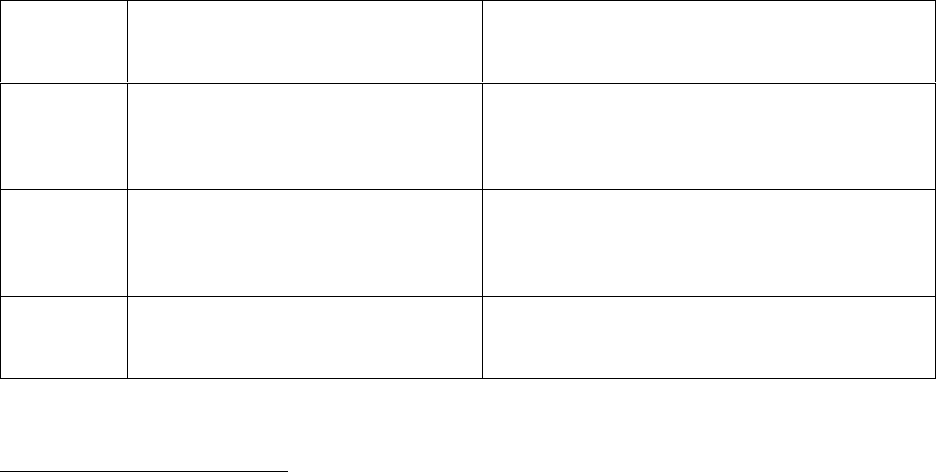
18
Therefore, no judgement on the intended convenience level can be made. The new Law on Waste and
Contaminated Soil for a Circular Economy only states that among the collection systems for the
mandatorily separately collected fractions that are implemented by the local entities, the most
efficient collection models must be prioritized, such as door-to-door or the use of closed or intelligent
containers that guarantee similar collection ratios. Moreover, to ensure effective systems for separate
collection, art. 25 of the Law establishes a maximum percentage of non-targeted materials allowed in
separately collected bio-waste, with the possibility of establishing such maximum levels also for other
waste fractions, and exceeding these percentages is considered an infraction (MITECO, 2022).
The new Law on Waste and Contaminated Soil for a Circular Economy continues to allow a co-mingled
collection of some of the waste fractions for which a separate collection obligation has been
established, as long as it does not hamper their subsequent recycling, among other conditions for
exemption
1
.
The Spanish authorities expect that some local entities will intend to move towards the possibility of
allowing non-packaging waste of similar materials to be deposited in the already existing bins for
separate collection, when it can be safely assumed that their presence does not negatively affect
recycling efforts.
In June 2021, the European Commission endorsed the Recovery and Resilience Plan for Spain
(European Commission, 2021). The Plan (Gobierno de España, 2021) considers a component (C12.I3)
that specifically refers to investments in support of the implementation of waste regulations. The
corresponding actions explicitly include the implementation of new separate collection systems,
especially for bio-waste, and the improvement of existing ones, budgeted at EUR 280 million (Ministry
for the Ecological Transition and the Demographic Challenge, 2021).
Summary result
Paper and
cardboard
N/A (for countries in which a high share
of the population is already covered by
high convenience collection services)
Metals
N/A (for countries in which a very high
share of the population is already
covered by high convenience collection
services)
Plastics
N/A (for countries in which a very high
share of the population is already
covered by high convenience collection
services)
Glass
N/A (for countries in which a high share
of the population is already covered by
high convenience collection services)
1
According to the Ministry for the Ecological Transition and the Demographic Challenge ‘prior assessment
of the Coordination Commission on waste may be exempted by regulation from the obligation to collect
waste separately, provided that at least one of the following conditions is met: a) The joint collection of
certain types of waste does not affect their suitability to be prepared for reuse, recycling or other recovery
operations […], and produces, after such operations, a result of a comparable quality and quantity
equivalent to that achieved by separate collection’

19
Bio-waste
There are plans to improve the
collection service but unclear plan for
implementation
A dedicated budget has been made available for
implementation of new separate collection systems,
especially bio-waste, and improvement of existing
ones. With respect to bio-waste, coverage is
mandatory for municipalities with more than 5 000
inhabitants as of 30 June 2022, and will be nation-
wide as from 31 December 2023, as required by the
Waste Framework Directive, but there are no
specific requirements with respect to the character
of the system.
Wood
N/A (for countries in which a high share
of the population is already covered by
high convenience collection services)
A dedicated budget has been made available for
implementation of new separate collection systems
and improvement of existing ones. Separate
collection of bulky waste, including wooden
furniture and other household wood waste will be
mandatory over the whole territory, as from 31
December 2024, , as required by the Waste
Framework Directive, but there are no specific
requirements with respect to the character of the
system.
Textiles
There are plans to improve the
collection service but unclear plan for
implementation
A dedicated budget has been made available for
implementation of new separate collection systems
and improvement of existing ones. With respect to
textiles, coverage is planned to be nation-wide as
from 31 December 2024, but there are no specific
requirements with respect to the character of the
system.
WEEE
There are plans to improve the
collection service but unclear plan for
implementation
A dedicated budget has been made available for
implementation of new separate collection systems
and improvement of existing ones.
Robustness of the underlying information
The new Law on Waste and Contaminated Soil for a
Circular Economy does not contain national
requirements on the type and convenience levels of
the collection systems, the implementation of which
falls under the responsibility of the local authorities.
The Law however states that among the collection
systems for the mandatorily separately collected
fractions that are implemented by the local entities,
the most efficient collection models must be
prioritized, such as door-to-door or the use of closed
or intelligent containers that guarantee similar
collection ratios.
2.1.5 Extended producer responsibility (EPR) and similar schemes
SRF MSWR-5.1: Fee modulation in EPR schemes for packaging
Within EPR schemes, fee modulation (or eco-modulation) is a system with different fees for different
types of packaging material and designs. While basic fee modulation, i.e. different fees for the main
material groups, are common, advanced fee modulation can create stronger incentives for packaging
producers to design for recycling and thus create favourable conditions for higher recycling rates. The
level of advancement of the fee modulation is assessed against four criteria that have been selected
as benchmarks for a well-designed eco-modulated fee system:

20
• recyclability, for example differentiating between PET and PS, between different colours of
PET, or between 100% cardboard boxes and laminated beverage cartons;
• sortability and disruptors, for example a malus for labels/caps/sleeves made of other
materials, which are not fitted for the recycling technologies of the main packaging;
• recycled content; and
• if there is a transparent compliance check by the PRO that producers report correctly.
In Spain, there is a differentiated fee by type of material for packaging, and additional differentiations
apply within some material groups, such as steel and aluminium in the case of metal packaging, and
PET and different types of HDPE and LDPE in the plastic packaging group. The fees are said to have
been calculated to cover the extra cost of the selective collection of packaging waste, depending on
the type of material
2
. Currently, no mention is made of any of the assessment criteria of advanced fee
modulation. The text of the new Law on Waste and Contaminated Soil for a Circular Economy only
refers to the possibility of eco-modulation in generic terms
3
.
The version of 28 September 2021 of the draft Royal Decree on Packaging and Packaging Waste
(Ministerio para la Transición Ecológica y el Reto Demográfico, 2021) however, incorporated minimum
requirements for the modulation of the financial contribution to collective PRO:
1. Regarding the modulation criterium of recyclability, in Annex VIII of the draft Royal Decree it
is considered as a bonus ‘the improvement of the recyclability of packaging, which must be
audited and certified by entities other than the packaging producers and the product
producers themselves and in close collaboration with the waste managers’.
2. Regarding the presence of disruptors and sortability, Annex VII establishes as a malus:
a. The presence of disruptors affecting sorting or recycling, whatever the percentage of
the disruptor.
b. The presence of substances after recycling that may compromise the use of the
recycled material.
c. The need to implement specific measures to ensure the recycling of certain categories
of packaging.
3. It also establishes specific maluses for several disruptors present in packaging made of certain
materials (glass, paper/cardboard, PET, rigid plastic, and PVC).
4. With respect to recycled content, Annex VII establishes the incorporation of secondary raw
materials that originates from the recycling of packaging as a bonus, with a lower weight for
non-recyclable packaging or packaging with low recyclability as compared to more easily
recyclable packaging, as to account for the possible future loss of materials.
5. Regarding the criterium of a transparent compliance check, article 21 of the draft version
stated that PROs, both individual and collective, must implement an adequate self-monitoring
system to evaluate the quality of the data collected and reported in their annual reports,
supported by independent audits.
Furthermore, this 28 September 2021 version of the draft of the new Spanish packaging legislation
established possible criteria to modulate the financial contributions of producers for each type of
similar packaging, taking into account the nature and quantity of the materials used in its
2
https://www.ecoembes.com/es/empresas/ingresos-punto-verde/tarifa-punto-verde-por-material
3
The translated text reads: ‘The financial contribution paid by the producer of the product to fulfill its
obligations in terms of extended producer responsibility must […] in cases of collective compliance with
obligations, and as far as possible, be modulated for each product or group of similar products,
especially taking into account their durability, that they can be repaired, reused and recycled, and the
presence of hazardous substances’.
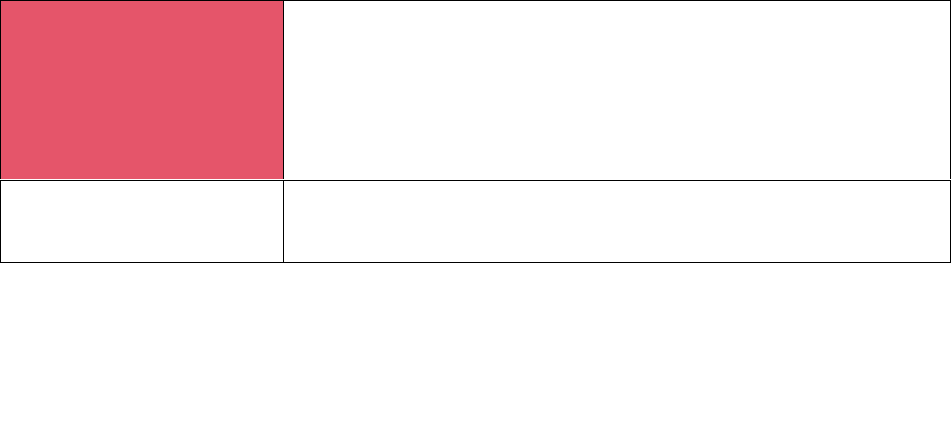
21
manufacture, including durability, repairability, reusability, and recyclability, their superfluity,
recycled content, the presence of hazardous substances or other factors that might affect reuse,
recycling or the incorporation of recycled content, among others. PROs were allowed to further
develop the modulation of financial contributions in a transparent and non-discriminatory manner,
adopting an approach based on the life cycle of packaging, taking these or similar criteria into account.
The draft included the provision of a forecast of the effects of the modulation within a period of 4
years, as well as the possibility of reviewing the criteria and making them binding.
The final draft text of the new packaging decree that was notified to the European Commission on 6
May 2022 (Ministerio para la Transición Ecológica y el Reto Demográfico, 2022), was however
reported (ANEABE Aguas Minerales de España, 2022) to have undergone important modifications in
relation to the one published by the Ministry for the Ecological Transition and Demographic Challenge
on 28 September 2021 (Ministerio para la Transición Ecológica y el Reto Demográfico, 2021) that was
discussed here above, and which was submitted to allegations in a public hearing. The present
assessment does not include an analysis of those modifications that affect or relate to fee modulation.
Summary result
No advanced fee modulation
Differentiated fees are applied for different packaging materials. Fees are
calculated to cover the extra cost of the selective collection of packaging waste,
and only depend on the type of material. Currently, no reference is made to any
of the criteria for assessment of advanced fee modulation. However, criteria for
advanced fee modulation taking into account all four assessment criteria have
been proposed in the draft new Spanish packaging legislation currently in
process.
Robustness of the underlying
information
Information provided by the Ministry for the Ecological Transition and the
Demographic Challenge retrieved from the Spanish household packaging PRO
website and the EU database on national technical regulations (TRIS).
2.1.6 Treatment capacity for bio-waste
SRF MSWR-6.1: Capacity for the treatment of bio-waste
Bio-waste is the largest single waste fraction in municipal waste, and adequate treatment capacity
needs to be made available.
The current capture rate of the total generation of bio-waste (food and garden) in Spain is estimated
to be only about 11 %, with a collection of 19 kgs/person/year in 2018 (Table 1.1). For food waste
alone, the capture rate was estimated to be 3 % (Zero Waste Europe, 2020). These figures indicate
that significant additional volumes of bio-waste to be collected are to be expected when extending its
separate collection as foreseen in the new Law on Waste and Contaminated Soil for a Circular
Economy.
The Spanish authorities acknowledge that the lack of investment is a key challenge to overcome, both
for the implementation of separate collection systems and for the construction of new facilities that
increase the existing capacity in order to treat additional, separately collected bio-waste. The earlier
mentioned (see 2.1.4) Recovery and Resilience Plan for Spain (Gobierno de España, 2021), already
endorsed by the European Commission (European Commission, 2021), includes a component (C12.I3)
that refers to investments in the construction of specific facilities for the treatment of separately
collected bio-waste (EUR 96.2 million) and in the improvement of existing MBT plants, among others,
aligned with the Study on investment needs in the waste sector and on the financing of municipal
waste management in Member States (COWI et al., 2019). Indeed, investment needs in the waste
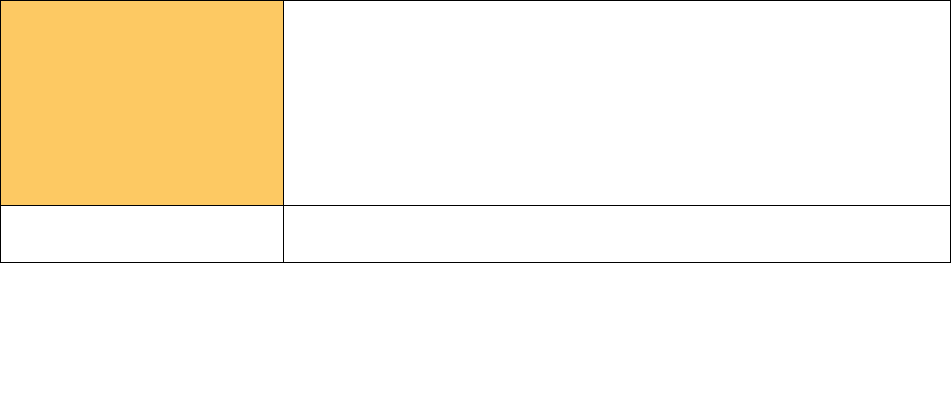
22
sector in Spain are among the highest in Europe for the coming years. For instance, with regard to the
costs associated with replacement of bio-waste facilities that have reached end-of-life, for the period
from 2021 to 2035, Spain ranks fourth among the EU Member States, with a total estimated cost of
EUR 270 million, of which EUR 77 million corresponds to the replacement of open air composting
facilities, EUR 39 million to in-vessel composting, and EUR 155 million to anaerobic digestion
(European Commission, 2019).
The 2019 annual report published on the website of the Ministry for the Ecological Transition and the
Demographic Challenge (Ministerio para la Transición Ecológica, nd), does not include information on
investments in bio-waste collection and treatment that are realized or planned by the regions.
However, in accordance with the distribution of competences for waste management in Spain, part of
the above mentioned funds foreseen in the Recovery and Resilience Plan (Gobierno de España, 2021)
have already been distributed in the 2021 budget to the Autonomous Regions for implementing the
corresponding actions. The timeframe established for the investments covers the period from March
2020 to May 2026. However, investments that specifically target bio-waste, taking into account the
obligation of its separate collection and treatment foreseen in both the Waste Framework Directive
and the new Law on Waste and Contaminated Soil for a Circular Economy, are likely to be the first to
be addressed by the regions. (Ministry for the Ecological Transition and the Demographic Challenge,
2021)
No quantitative information was provided by the Spanish authorities on the existing, planned or
projected capacities of bio-waste treatment facilities. Reported capacity, from data corresponding to
35 of the 50 existing bio-waste treatment facilities, covers 81 % of the municipal bio-waste that was
separately collected in 2018. Currently, not more than 11 % of the organic fraction of MSW generated
in Spain is separately collected. At the same time, bio-waste accounts for 47.2 % of the total volume
of mixed residual waste collected in Spain (2010 reference), which corresponds to a total volume of
8.3 million tonnes of bio-waste. The residual waste, including the bio-waste contained in it, is either
directly landfilled or incinerated, or goes to composting or anaerobic digestion in MBT plants, were a
bio-stabilized material is produced that cannot be used as compost. (Ministry for the Ecological
Transition and the Demographic Challenge, 2021)
It can thus be concluded that there is not enough bio-waste treatment capacity, not even for half of
the bio-waste currently contained in the residual MSW.
Summary result
Bio-waste capacity below 80 %
of generated municipal bio-
waste but firm plans to close
the gap
Reported capacity, from data corresponding to 35 of the 50 existing bio-waste
treatment facilities, covers 81 % of the municipal bio-waste that was separately
collected in 2018. There is currently no capacity to treat a significant part of the
8.3 million tons of potentially generated bio-waste that is currently being
collected as part of the mixed MSW. However, since March 2020, earmarked
funding has been made available for the construction of specific facilities for the
treatment of separately collected bio-waste, and for the improvement of
existing MBTs.
Robustness of the underlying
information
Available quantitative information does not fully cover existing, planned or
projected capacity for the treatment of bio-waste.
SRF MSWR-6.2: Legally binding national standards and Quality Management System for
compost/digestate
To create a market for compost and digestate, they should be of a good quality for use as a soil
improver or fertilizer. Legally binding standards provide guarantees regarding the quality of the
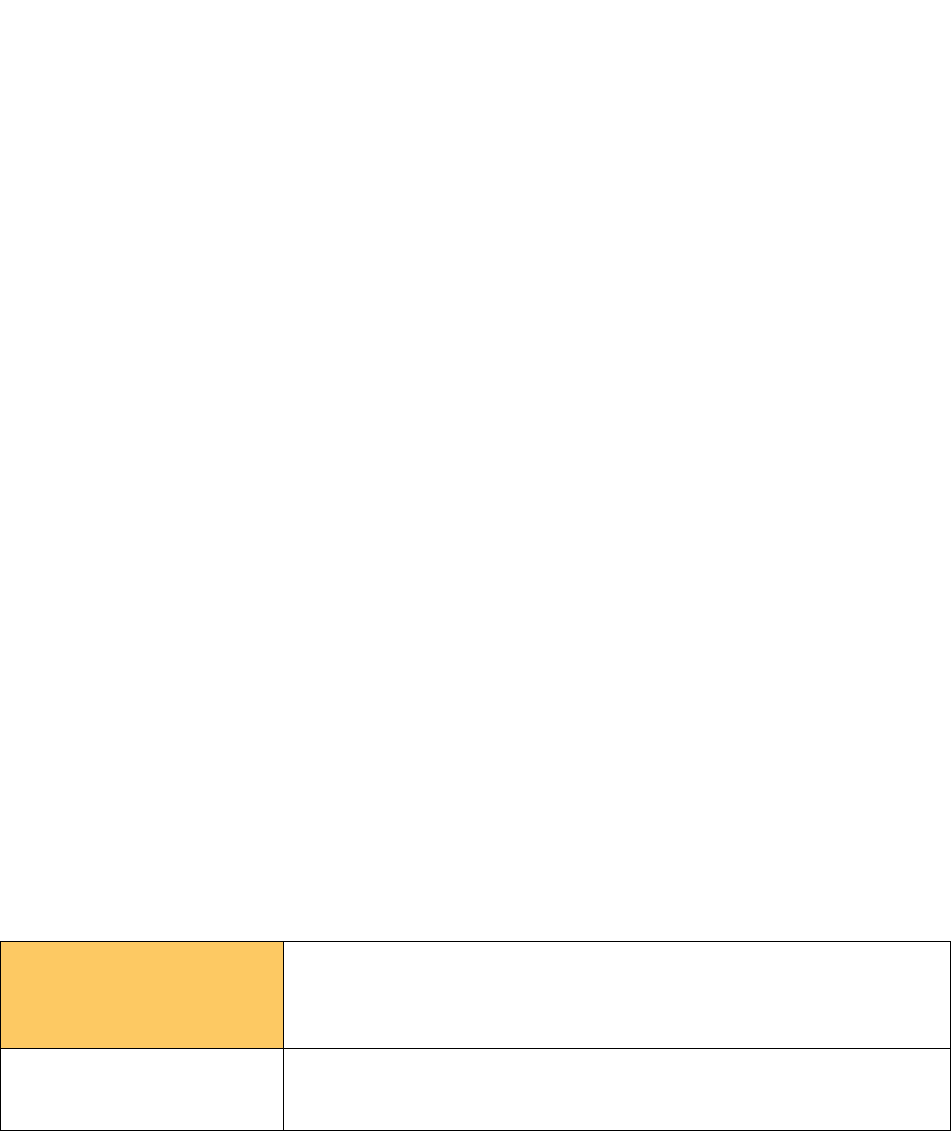
23
compost/digestate produced. A quality management system aims at addressing different elements of
a production process to ensure a stable and high-quality output (product) which helps toward reaching
a defined quality for the product.
Spain is reported to have mature national standards for compost quality embedded in national
legislation while the implementation of a quality assurance system for the production of compost from
bio-waste has not yet started (EEA, 2020). Nevertheless, the Spanish Fertilisers Regulation (Ministerio
de la Presidencia, 2013) includes, among other requirements, in its article 12 the requirements for the
producer of fertilisers, including some requirements for quality management. Besides, in article 14
there are requirements for internal quality control systems for manufacturers of fertiliser products.
According to this Regulation three-monthly analyses are required for organic products to verify
compliance with the requirements of Annex V, which include requirements for organic nitrogen,
moisture, particle size, hygienisation (microorganisms), heavy metals, use limitations, furfural and
polyphenols. The Spanish Fertilisers Regulation (Ministerio de la Presidencia, 2013) categorises
compost under five kinds according to the raw materials used (organic amendment compost, manure
compost, green compost, vermicompost, and ‘alperujo’ compost), and distinguishes three different
quality levels depending exclusively on the compost’s heavy metals content. The organic fraction of
municipal waste not separately collected was used, among other organic fractions, to produce organic
amendment type compost, until in 2013, this fraction was no longer legally allowed for producing
compost. Separately collected organic municipal waste so far only contributed marginally to the
production of officially registered organic amendment composts in Spain (Puyuelo et al., 2019). The
Spanish authorities expect that the legal obligation to implement the separate collection of bio-waste
established in the new Law 7/2022 on Waste and Contaminated Soil for a Circular Economy, as well
as the investments foreseen under the Recovery and Resilience Funds to implement such separate
collection, will increase the production of high quality compost to be used as fertiliser.
Article 28 of the new Law 7/2022 on Waste and Contaminated Soil for a Circular Economy establishes
at national level end-of-waste criteria for compost and digestate. These criteria are the same as those
set out at EU level in the Fertilizing Products Regulation ((EU) 2019/1009). In addition, the Spanish
Fertilisers Regulation (Ministerio de la Presidencia, 2013) is to be amended to achieve coherence with
Regulation (EU) 2019/1009 and with the new end-of-waste criteria for compost and digestate
established by Law 7/2022 at national level. (MITECO, 2022)
Summary result
Legally binding national
standards for
compost/digestate quality but
no quality management system
The Spanish Fertilisers Regulation categorises compost in five categories
according to the raw materials used and distinguishes three different quality
levels depending exclusively on the compost’s heavy metals content.
Robustness of the underlying
information
Legal text available (Ministerio de la Presidencia, 2013), and information
provided by the Ministry for the Ecological Transition and the Demographic
Challenge.

24
2.2 Target for the recycling of packaging waste
This chapter aims at assessing the prospects of the Spain to achieve the 65 % recycling target for
packaging waste in 2025 as well as the material specific packaging waste recycling targets (50 % of
plastic; 25 % of wood; 70 % of ferrous metals; 50 % of aluminium; 70 % of glass; 75 % of paper and
cardboard). In order to conclude on this likelihood, the analysis takes stock of the status of several
factors that are proven to influence the levels of recycling in a country. For a detailed description of
the methodology followed, the development of success/risk factors and their impact on recycling,
please consult the methodology report (ETC/CE & ETC/WMGE, 2022).
2.2.1 Current situation and past trends
SRF P-1.1 Distance to target
The actual distance to the target for the most recent data point is a key factor determining the
likelihood of meeting or not meeting the target. This analysis is based on data reported by Spain to
Eurostat in accordance with Commission Decision 2005/270/EC as last amended by the Commission
Implementing Decision 2019/665 (EC, 2019), published in the dataset Recycling rates of packaging
waste for monitoring compliance with policy targets, by type of packaging [env_waspacr]. The latest
available data refer to 2019. The performance of Spain for 2019 is illustrated in Figure 2.2.
Figure 2.2 Packaging recycling rates for Spain in 2019, in percentage
Source: Eurostat (2022d), EU (2018)
For Spain, the reported recycling rates in 2019 for total packaging, plastics, wooden and glass
packaging already exceed the 2025 targets. For paper and cardboard, the distance to target is only 2.1
percentage points. Ferrous metals exceed the target by 28.8 percentage points. For aluminium
packaging the distance to target is just 0.1 percentage point.
However, the recycling rates presented here are based on the calculation rules of the Commission
Decision 2005/270 before it was amended by the Commission Implementing Decision 2019/665, and
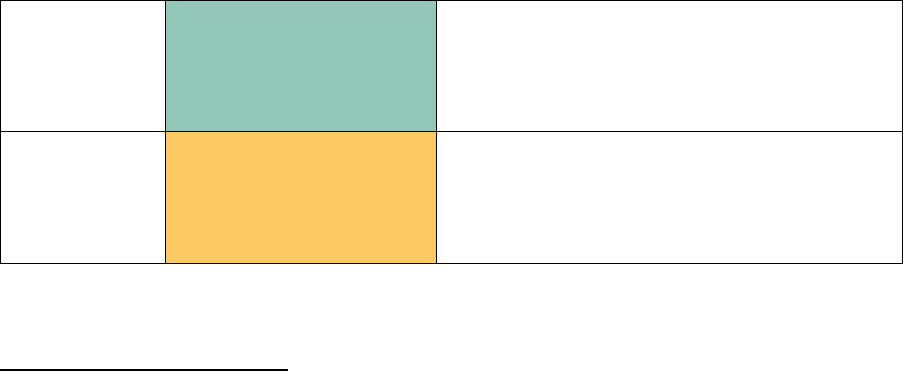
25
the new calculation rules will only be mandatory to be used for the reference year 2020 and onwards.
A key difference in the new calculation rules compared to the old rules is that the amount of sorted
packaging waste that is rejected by the recycling facility shall not be included in the reported amount
of recycled packaging waste.
As a matter of sensitivity analysis, to assess what the impact of these new calculation rules could be
(change in calculation point), recycling losses found in literature (EXPRA, 2014) are applied to the
packaging recycling rates as reported for reference year 2019:
• Paper and cardboard packaging: decrease by 10 %, from 72.9 % to 65.6 %
• Plastic packaging: decrease by 21 %
4
, from 51.5 % to 40.6 %
• Metal packaging: decrease by 14 %, from 98.8 % to 85.0 % for ferrous metals, and from 49.1
% to 42.2 % for aluminum
• Glass packaging: decrease by 5 %, from 79.8 % to 75.8 %
• Wooden packaging: decrease by 11 % from 66.9% to 59.5 %
• Total packaging: calculated based on the amounts of each packaging material generated and
recycled in 2019, the recycling rate would drop from 69.6 % to 62 %.
Taking these recycling loss rates into account would result in plastic packaging and paper and
cardboard packaging not meeting the recycling target anymore. Next to this, the Spanish authorities
have identified a traceability problem with respect to the packaging waste data, which is intended to
be addressed through the register of product producers that is considered in the draft legislation on
packaging waste (Ministerio para la Transición Ecológica y el Reto Demográfico, 2022) that is expected
to be adopted at the end of 2022 (MITECO, 2022). No estimates are made for packaging put on the
market by free riders, de minimis, online sales and private imports/exports (Eurostat, 2021b). A study
is currently being carried out to estimate free riders in household packaging. It is expected to be
completed by the end of 2022 (MITECO, 2022).
In addition, according to the calculated capture rates for paper and cardboard, plastic, metals and
glass (Section 1.3), a considerable amount of these materials are included in the mixed municipal
waste although not all of this material is packaging. Nevertheless, comparing the rather high recycling
rates with the rather low or modest capture rates from municipal waste gives some indication that
the reported recycling rates might be overestimated.
Summary result
Total packaging
< 5 percentage points below
target
Spain reports a recycling rate of 69.6 %. However if
the new calculation rules are applied (taking into
account losses in the recycling plants), the estimated
recycling rate would drop to 62.0 %, 3.0 percentage
points below the 2025 target.
Paper and
cardboard
packaging
5 - 15 percentage points
below target
Spain reports a recycling rate of 72.9 %. However if
the new calculation rules are applied (taking into
account losses in the recycling plants), the estimated
recycling rate would drop to 65.6 %, 9.4 percentage
points below the 2025 target.
4
This is the weighted recycling loss taking into account the 29 % recycling loss for packaging waste from
household sources (66 %) and the 5 % recycling loss for packaging waste from commercial sources (33 %).
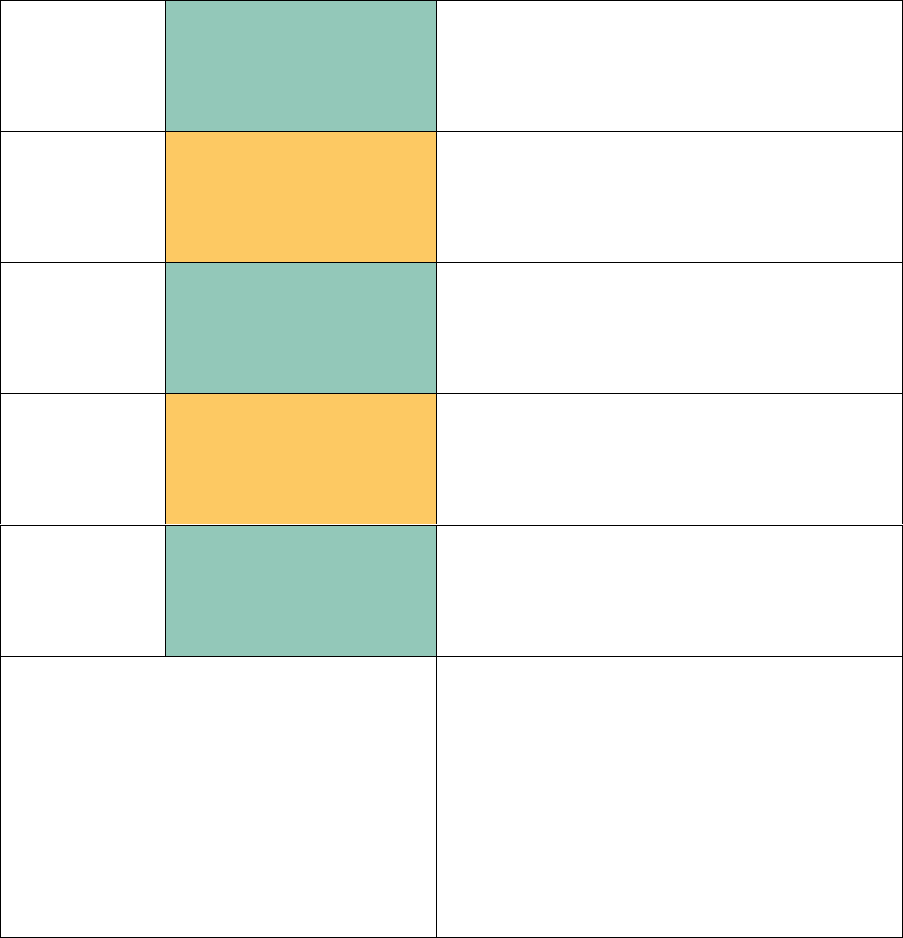
26
Ferrous metals
packaging
Target exceeded
Spain reports a recycling rate of 98.8 %. However if
the new calculation rules are applied (taking into
account losses in the recycling plants), the estimated
recycling rate would drop to 85.0 %, 15 percentage
points above the 2025 target.
Aluminium
packaging
5 - 15 percentage points
below target
Spain reports a recycling rate of 49.1 %. However if
the new calculation rules are applied (taking into
account losses in the recycling plants), the estimated
recycling rate would drop to 42.2 %, 7.8 percentage
points below the 2025 target.
Glass packaging
Target exceeded
Spain reports a recycling rate of 79.8 %. However if
the new calculation rules are applied (taking into
account losses in the recycling plants), the estimated
recycling rate would drop to 75.8 %, 5.8 percentage
points above the 2025 target.
Plastics
packaging
5 - 15 percentage points
below target
Spain reports a recycling rate of 51.5 %. However if
the new calculation rules are applied (taking into
account losses in the recycling plants), the estimated
recycling rate would drop to 40.6 %, 9.4 percentage
points below the 2025 target.
Wooden
packaging
Target exceeded
Spain reports a recycling rate of 66.9 %. However if
the new calculation rules are applied (taking into
account losses in the recycling plants), the estimated
recycling rate would drop to 59.5 %, 34.5 percentage
points above the 2025 target.
Robustness of the underlying information
The assessment is limited by the fact that the
recycling rates for 2019 reported by Spain to Eurostat
do not yet reflect the new calculation rules, and the
impact of the new calculation rules has therefore
been estimated based on literature.
It is possible there is underreporting of the generated
packaging waste, related to the use of industry
declarations to obtain data on packaging waste
generated for packaging other than glass, while no
general estimates are used to improve coverage of
data on packaging waste generated (Eurostat, 2022a).
SRF P-1.2: Past trend in packaging waste recycling
The development of the historical trend in the recycling rate indicates previous efforts towards
packaging waste recycling. In this analysis the recycling rate reported in the Eurostat dataset Recycling
rates of packaging waste for monitoring compliance with policy targets, by type of packaging
[env_waspacr] (latest data year: 2019) is used. The recycling trends for packaging waste by material
in Spain are illustrated in Figure 2.3.

27
Figure 2.3 Trend in packaging waste recycling rates in Spain between 2015 and 2019, in percentage
Note: Spain reported separate data for aluminium and steel packaging for the first time in 2018,
therefore the trend is shown only for metallic packaging.
Source: Eurostat (2022d)
Overall, the recycling levels of packaging remained rather stable over the past five years. The recycling
rate for paper and cardboard packaging however strongly decreased since 2016.
Summary result
Total packaging
RR > 60% and increase in
last 5 years < 5 percentage
points
The recycling rate increased by 1.2 percentage points
over the past five years and is estimated at 62.0 % if
the new calculation rules would be applied (taking into
account losses in the recycling plants)
Paper and
cardboard
packaging
RR > 65%, and increase in
last 5 years < 10 percentage
points
The recycling rate decreased by 4.0 percentage points
over the past five years and is estimated at 65.6 % if
the new calculation rules would be applied (taking into
account losses in the recycling plants)
Ferrous metals
packaging
RR > 70%
The recycling rate of total metals packaging increased
by 4.1 percentage points over the past five years and is
estimated at 85 % if the new calculation rules would be
applied (taking into account losses in the recycling
plants)
Aluminium
packaging
RR > 40%, and increase in
last 5 years < 10 percentage
points
The recycling rate of total metals packaging increased
by 4.1 percentage points over the past five years and is
estimated at 42.2 % if the new calculation rules would
be applied (taking into account losses in the recycling
plants)
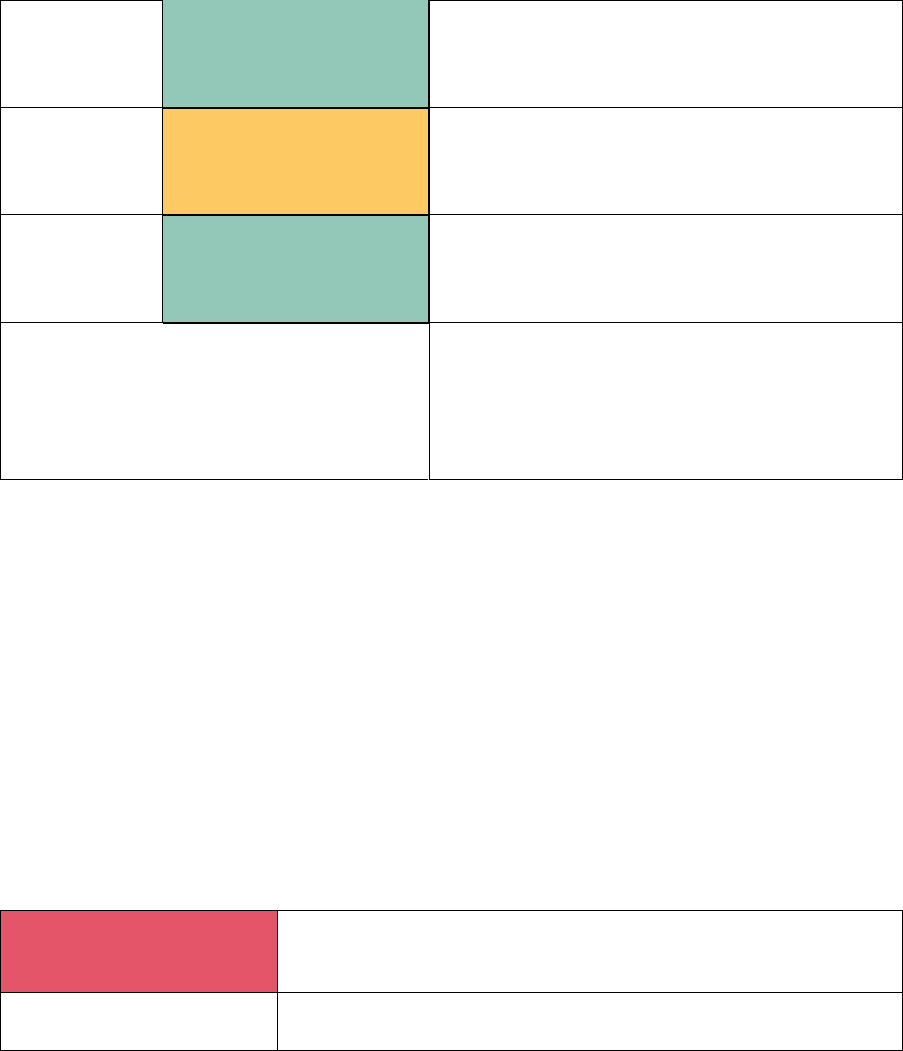
28
Glass packaging
RR > 70%
The recycling rate increased by 9.4 percentage points
over the past five years and is estimated at 75.8 % if
the new calculation rules would be applied (taking into
account losses in the recycling plants)
Plastics
packaging
RR > 40% and increase in
last 5 years < 10 %
The recycling rate increased by 7.5 percentage points
over the past five years and is estimated at 40.6 % if
the new calculation rules would be applied (taking into
account losses in the recycling plants)
Wooden
packaging
RR > 25%
The recycling rate increased by 1.4 percentage points
over the past five years and is estimated at 59.5 % if
the new calculation rules would be applied (taking into
account losses in the recycling plants)
Robustness of the underlying information
It is possible there is underreporting of the generated
packaging waste, related to the use of industry
declarations to obtain data on packaging waste
generated for packaging other than glass, while no
general estimates are used to improve coverage of data
on packaging waste generated (Eurostat, 2021b).
2.2.2 Legal instruments
SRF P-2.1: Timely transposition of the revised Packaging and Packaging Waste Directive into national
law
Timely transposition of the Packaging and Packaging Waste Directive as amended by Directive
2018/852, into national law within the foreseen period is key for a waste management system in line
with EU requirements.
Directive (EU) 2018/852 on packaging and packaging waste is still in the process of transposition in
Spain, although approval and adoption were initially expected by the end of 2020 (European
Environmental Bureau, 2020). The approval of the DRDPPW, scheduled for the end of 2022, is
expected to complete the transposition in Spain of Directive (EU) 2018/852 (MITECO, 2022).
Summary result
No full transposition yet
The approval of the draft Royal Decree on Packaging and Packaging
Waste, scheduled for the end of 2022, is expected to complete the
transposition in Spain of Directive (EU) 2018/852.
Robustness of the underlying
information
Full information on the progress of the legislative process is publicly
available.
SRF P-2.2: Responsibilities for meeting the targets, and enforcement mechanisms, e.g. fines etc.
Royal Decrees will specify obligations of extended producer responsibility organisations for each
specific waste stream. These obligations include the setting of waste management objectives that, as
a minimum, must be achieved.
The new Law 7/2022 on Waste and Contaminated Soil for a Circular Economy contains a chapter that
is dedicated to the sanctioning regime and updated Law 22/2011 on Waste and Contaminated Soil
previously in force. For this purpose, certain offenses and penalties have been defined with greater
precision, especially those relating to extended producer responsibility.
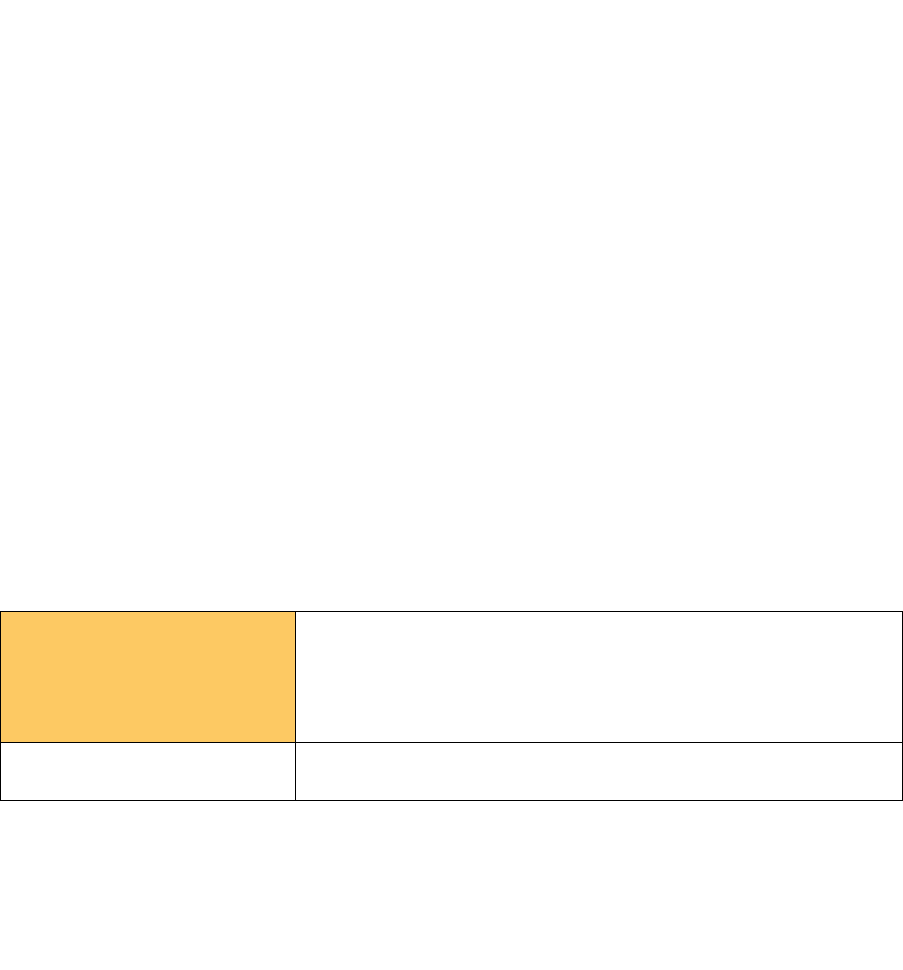
29
Regarding extended producer responsibility organisations, the new Law 7/2022 on Waste and
Contaminated Soil for a Circular Economy establishes non-compliance with the defined targets for
these organisations as an infraction. In the new Law, a separate chapter is dedicated to the sanctioning
regime and supposes an update of the content of the preceding Law on Waste and contaminated Soils.
To this end, certain infractions and sanctions have been classified with greater precision, especially
those related to the EPR. In the event of non-compliance with the obligations of extended producer
responsibility by the individual or collective systems, the competent authority to initiate the
sanctioning procedure will be the autonomous community corresponding to the territory where the
infraction is committed, which may also suspend the activity of the system in its territory. The new
Law states that in the case of the regulation regarding EPR, the adaptation of the regulations
corresponding to the provisions of this Law will be carried out before 5 January 2023. Article. 41 of
the new Law on Waste, indicates that the quantitative targets applied to the PROs will be consistent
with the recycling targets, so that the sanction for non-compliance with these EPR targets could be
considered equivalent to a sanction for not reaching the recycling targets.
The Ministry for the Ecological Transition and the Demographic Challenge (MITECO) indicates that the
new Law on Waste and Contaminated Soil for a Circular Economy establishes that, to prevent free-
riding of EPR obligations, the e-commerce platforms would be considered producers of products and,
therefore, will have to comply with the corresponding EPR obligations (Ministry for the Ecological
Transition and the Demographic Challenge, 2021).
Summary result
Clearly defined responsibilities
and enforcement mechanisms
but no/weak support tools for
meeting the recycling targets
The responsibility for reaching the targets is set on PROs. Objectives
and targets are set in Royal Decrees, per material type. The new Law on
Waste updates the existing sanctioning regime and introduces explicit
dispositions with respect to the obligations of e-commerce platforms.
However, there are no support tools in place.
Robustness of the underlying
information
The text of the newly approved Law on Waste and Contaminated Soil for
a Circular Economy is publicly available.
2.2.3 Economic instruments
SRF P-3.1: Taxes and/or ban for landfilling residual- or biodegradable waste
Bans and taxes on landfilling of residual waste can help to discourage landfilling and thus support
recycling, also of packaging waste.
As described in Section 2.1.3 in more detail, regional landfill taxes and landfill bans on biodegradable
or non-treated waste are in place. The new Law on Waste and Contaminated Soil for a Circular
Economy considers a national landfill tax that substitutes previously existing regional taxes. A
Ministerial Order will contain a list of wastes that cannot be landfilled, which will include, among
others, a prohibition to directly landfill municipal waste that is suitable for preparation for reuse,
recycling or other recovery.

30
Summary result
Yes, taxes > 30 EUR/t(
a
)
Minimum tax rates contained in the new Law on Waste and Contaminated
Soil for a Circular Economy:
• MSW Landfill tax: 40 EUR/t (corresponding to 41.9 EUR/t rescaled
based on purchasing power parities)
• Tax for rejects from pre-treatment: 30 EUR/t (corresponding to
31.4 EUR/t rescaled based on purchasing power parities)
No escalators are included on the national level.
Robustness of the underlying
information
The tax rates are contained in the approved text of the new Law on Waste
and Contaminated Soil for a Circular Economy.
(
a
) Note: Rescaled based on purchasing power parities Eurostat (2020a)
SRF P-3.2: Taxes on municipal waste incineration
Taxes on incineration of residual waste can help to discourage strong reliance on residual waste
treatment and thus support recycling. As described in Section 2.1.3 in more detail, Spain will also
introduce a tax on incineration at the national level, which will replace the few incineration taxes
currently established by the regional authorities.
Summary result
Yes, taxes > 7 EUR/t(
a
)
• MSW incineration facilities coded as D10: MSW 20 EUR/t and
reject MSW 15 EUR/t (corresponding to respectively 20.9 EUR/t
and 15.7 EUR/t rescaled based on purchasing power parities)
• MSW incineration facilities coded as R01: MSW 15 EUR/t and
reject MSW 10 EUR/t (corresponding to respectively 15.7 EUR/t
and 10.5 EUR/t rescaled based on purchasing power parities)
• Other incineration facilities: MSW 20 EUR/t and reject MSW 15
EUR/t (corresponding to respectively 20.9 EUR/t and 15.7 EUR/t
rescaled based on purchasing power parities)
No escalator is foreseen on the national level.
Robustness of the underlying
information
The tax rates are contained in the approved text of the new Law on Waste
and Contaminated Soil for a Circular Economy.
(
a
) Note: Rescaled based on purchasing power parities Eurostat (2020a)
SRF P-3.3: Packaging taxes
Packaging taxes can support the aim to reduce packaging waste generation and/or to influence the
choice of packaging materials and encourage recyclability and eco-design.
According to the information available, currently a tax of 0.1 EUR/plastic bag on disposable plastic
bags is in place in Andalusia. The new Law on Waste and Contaminated Soil for a Circular Economy
introduces a national tax on the manufacture, import or intra-community acquisition of non-reusable
plastic packaging, including the packaging types specified in Directive 94/62/EC on packaging and
packaging waste. However, in order to promote the recycling of plastic products, the amount of
recycled plastic contained in products that are targeted by the tax will not be taxed. Thereto, the tax
base will be constituted by the amount of non-recycled plastic, expressed in kilograms, contained in
the products subject to the tax. This national tax rate on single-use plastic packaging −as well as on all
non-reusable plastic products that serve to contain liquid or solid products, or to wrap goods or food
products− is set to 0.45 EUR/kg. No other material than plastic packaging is targeted.
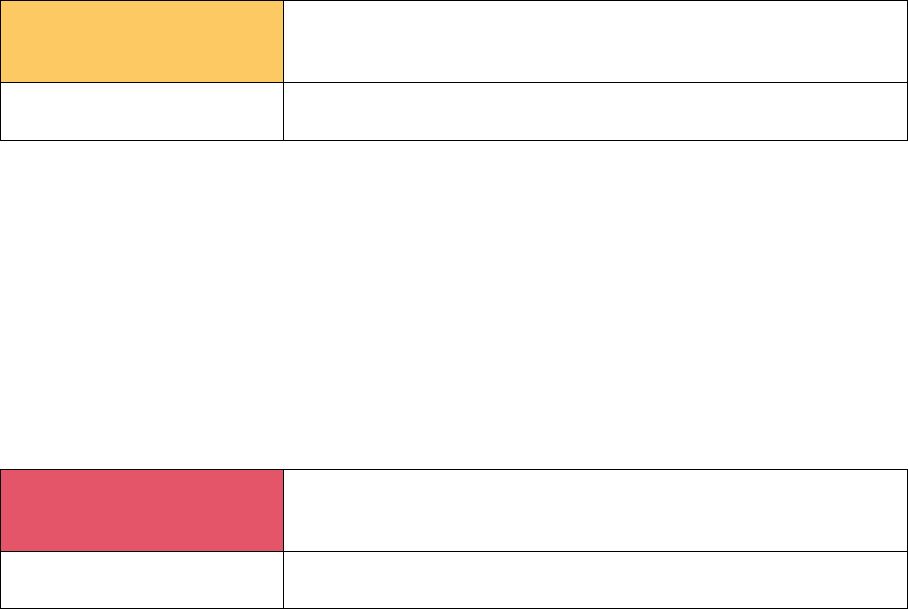
31
Summary result
Limited packaging tax
A national tax of 0.45 EUR/kg of non-recycled plastic contained in non-
reusable plastic packaging is introduced in the new Law on Waste and Soil
Contamination. The tax is limited to plastics packaging only.
Robustness of the underlying
information
The tax rate is contained in the approved text of the new Law on Waste
and Contaminated Soil for a Circular Economy.
SRF P-3.4: Pay-as-you-throw (PAYT) system in place
As a large share of packaging waste is generated in households, incentivising households to separate
packaging waste at source, e.g. by applying PAYT systems, is relevant for meeting the recycling targets
for packaging waste.
In Spain, PAYT schemes are applied in 16 municipalities out of almost 9 000. Moreover, the existing
PAYT in Spain are volume-based, and there are no weight-based schemes (European Commission,
2019).
Summary result
Less than 50% of the population
covered by PAYT
Far less than 50 % of the population is covered by PAYT schemes. The latest
information available indicates 16 out of 9 000 municipalities had such
schemes in place.
Robustness of the underlying
information
No quantitative data on PAYT are available.
SRF P-3.5: Deposit return systems
Deposit Return Systems (DRS) generate high capture rates for packaging covered by the system and
thus contribute to increased recycling rates.
No DRS systems are currently in place in Spain. However, the new Law on Waste and Contaminated
Soil for a Circular Economy establishes separate collection objectives for single use plastic bottles, with
the purpose of allocating them to recycling:
• By 2023 at the latest, 70 % by weight of that put on market;
• By 2025 at the latest, 77 % by weight of that put on market;
• By 2027 at the latest, 85 % by weight of that put on market;
• By 2029 at the latest, 90 % by weight of that put on market.
The put-on market weight of these products may be considered equivalent to the amount of waste
generated from them, including the part that is littered, in that same year. If the objectives set in 2023
or 2027 are not met, at the national level, a DRS will be implemented throughout the territory within
two years, to guarantee compliance with the objectives in 2025 and 2029 respectively.

32
Summary result
Aluminium drink cans
No DRS for drink cans
Currently, no DRS systems are in place in
Spain.
Plastic bottles
No DRS for drink bottles
Currently, no DRS systems are in place in
Spain. A DRS for single use plastic bottles will
be introduced if the 2023 or 2027 separate
collection objectives as set in the new Law on
Waste and Contaminated Soil for a Circular
Economy are not met.
Plastic crates
No DRS for plastic crates
No DRS systems are in place in Spain.
Glass bottles
No DRS for drink bottles
No DRS systems are in place in Spain.
Wooden packaging
No DRS for wooden
packaging
No DRS systems are in place in Spain.
Robustness of the underlying information
Information included in the legislation.
2.2.4 Separate collection system
SRF P-4.1: Convenience and coverage of separate collection for different packaging waste fractions
As a large part of packaging waste comes from households, separate collection systems for households
and similar sources are a key condition for achieving high recycling rates for packaging waste and for
collecting recyclables at adequate quality. Such systems generally deliver better results the more
convenient and accessible they are for their users, also compared to the collection of residual waste.
The material specific assessment considers packaging waste from both household and non-household
sources. For assessing the convenience and coverage of separate collection systems for households,
the same methodology is used here as described in section 2.1.4.
Spanish authorities have indicated (Ministry for the Ecological Transition and the Demographic
Challenge, 2021) that the new Law on Waste and Contaminated Soil for a Circular Economy and Law
11/1997 on Packaging and Packaging Waste that are currently in force, establish the obligation of
separate collection of packaging waste among other. The new Law on Waste and Contaminated Soil
for a Circular Economy explicitly indicates that the initial producer or other holder of non-hazardous
commercial waste must separate at source. The responsibility of the initial producers or other holders
of non-hazardous commercial waste is stated to end when they have delivered the waste in
conformity with all applicable regulations. In the case of commercial waste not managed by the local
entity, or industrial waste, separation at source and subsequent separate collection of paper, metals,
plastic and glass waste is mandatory. For industrial and commercial packaging waste in particular, the
separate collection obligations currently fall on the final holder of the packaging waste. A new Royal
Decree on Packaging and Packaging Waste that has been submitted to public consultation would
extend the application of the EPR to commercial and industrial packaging. This implies that the packers
that use this type of packaging will have to take charge of their waste. (MITECO, 2021).
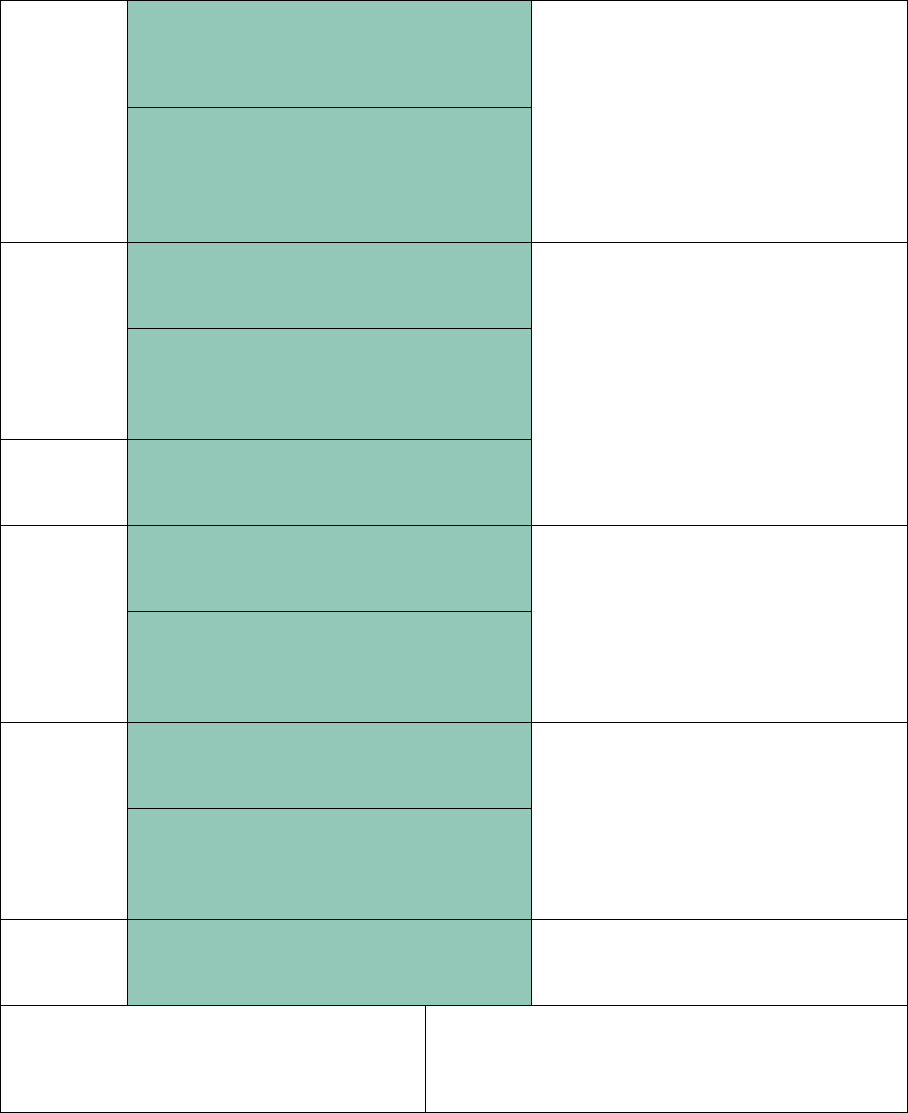
33
Summary result
Paper and
cardboard
packaging
1. Packaging waste from households
A high share of the population is covered by
high convenience collection services
High convenience collection systems have
been rolled out over the whole territory,
and also commercial sources and industry
will have to sort packaging waste at source.
2. Packaging waste from non-household
sources
Separation at source is mandatory for non-
household paper and cardboard packaging
waste
Ferrous
metals
packaging
1. Packaging waste from households
A high share of the population is covered by
high convenience collection services
High convenience collection systems have
been rolled out over the whole territory,
and also commercial sources and industry
will have to sort packaging waste at source.
No distinction is made at collection points
between steel and aluminum packaging
2. Packaging waste from non-household
sources
Separation at source is mandatory for non-
household ferrous metals packaging waste
Aluminium
packaging
Packaging waste from households
A high share of the population is covered by
high convenience collection services
Glass
packaging
1. Packaging waste from households
A high share of the population is covered by
high convenience collection services
High convenience collection systems have
been rolled out over the whole territory,
and also commercial sources and industry
will have to sort waste at source.
2. Packaging waste from non-household
sources
Separation at source is mandatory for non-
household glass packaging waste
Plastics
packaging
1. Packaging waste from households
A high share of the population is covered by
high convenience collection services
High convenience collection systems have
been rolled out over the whole territory,
and also commercial sources and industry
will have to sort packaging waste at source.
2. Packaging waste from non-household
sources
Separation at source is mandatory for non-
household plastics packaging waste
Wooden
packaging
Packaging waste from non-household sources
Separation at source is mandatory for non-
household wooden packaging waste
Robustness of the underlying information
The information was provided by the Ministry for the
Ecological Transition and the Demographic Challenge
and extracted from the Spanish waste legislation in
force.
Note: The main source for aluminium packaging waste is drink cans from households, therefore the
assessment does not consider aluminium non-household waste.
SRF P-4.2: Firm plans to improve the convenience and coverage of separate collection for the different
packaging waste fractions
Concrete plans are needed to improve the type and coverage of separate collection. This SRF is more
relevant for MS and materials that do not score ‘green’ in SRF P-4.1. The assessment is done on a
material basis and summing up the scores of the different materials according to their average share
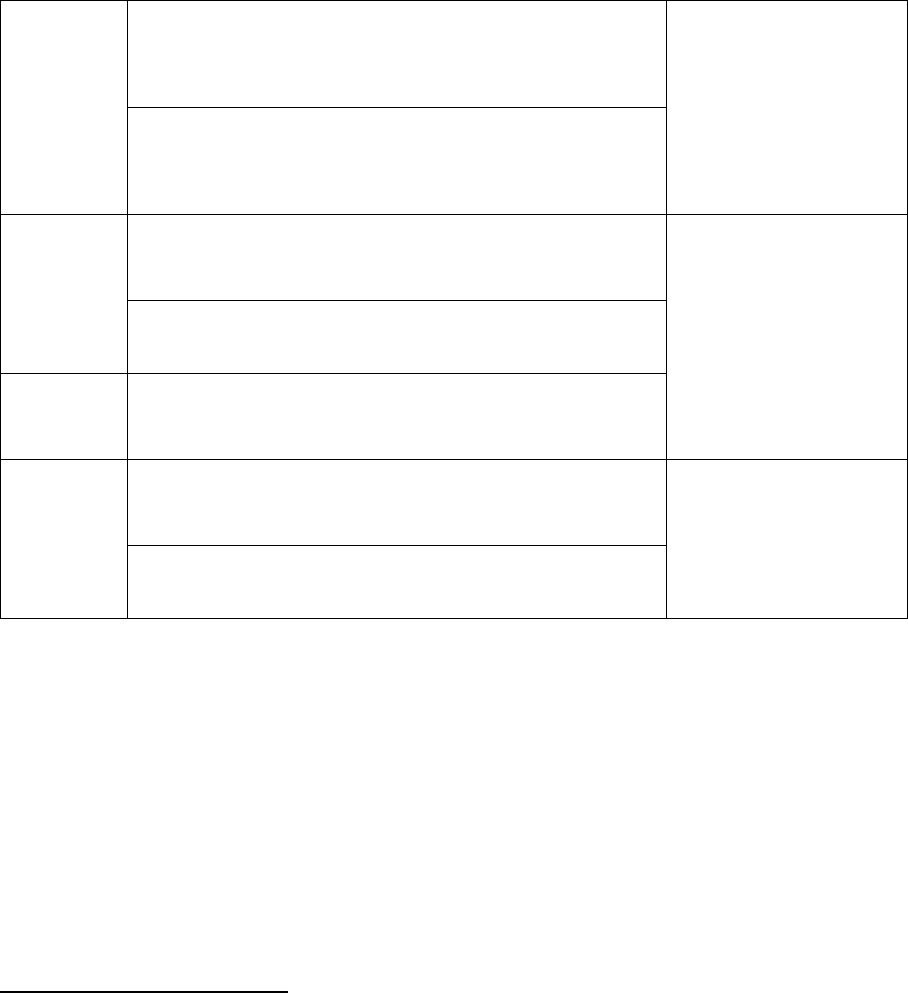
34
in packaging waste
5
. Again, the material specific assessment considers packaging waste from both
household and non-household sources. It is assumed that these sources are of similar size, since Spain
did not provide information on the shares of household/non-household waste generation.
Separate collection is mandatory for all packaging in the current packaging legislation, which also
includes commercial and industrial packaging, but the obligations in this case fall on the final holder
of the packaging waste. A new Royal Decree on Packaging and Packaging Waste that has been
submitted to public consultation would extend the application of the EPR to commercial and industrial
packaging, which until now was only applied to them on a very limited basis: compulsorily for the
packaging, of all material types, of plant protection products or voluntarily for the rest. This implies
that the packers that use this type of packaging will have to take charge of organizing and financing
the management of their waste (MITECO, 2021).
Summary result
Paper and
cardboard
packaging
1. Packaging waste from households
N/A (for countries in which a high share of the population is
already covered by high convenience collection services)
2. Packaging waste from non-household sources
N/A (for countries already having mandatory sorting at source)
Ferrous
metals
packaging
1. Packaging waste from households
N/A (for countries in which a high share of the population is
already covered by high convenience collection services)
2. Packaging waste from non-household sources
N/A (for countries already having mandatory sorting at source)
Aluminium
packaging
Packaging waste from households
N/A (for countries in which a high share of the population is
already covered by high convenience collection services)
Glass
packaging
1. Packaging waste from households
N/A (for countries in which a high share of the population is
already covered by high convenience collection services)
2. Packaging waste from non-household sources
N/A (for countries already having mandatory sorting at source)
5
Based on data from Eurostat on the share of packaging materials in total packaging generated in 2018

35
Plastics
packaging
1. Packaging waste from households
N/A (for countries in which a high share of the population is
already covered by high convenience collection services)
2. Packaging waste from non-household sources
N/A (for countries already having mandatory sorting at source)
Wooden
packaging
Packaging waste from non-household sources
N/A (for countries already having mandatory sorting at source)
Robustness of the underlying
information
The information was provided by the Ministry for the Ecological
Transition and the Demographic Challenge and extracted from the
Spanish waste legislation in force.
2.2.5 Extended producer responsibility (EPR) and similar schemes
SRF P-5.1: Coverage of EPR schemes
The following EPR system(s) are in place for packaging in Spain:
• ECOEMBES (Ecoembalajes España SA), covering lightweight packaging, and paper and
cardboard, from households;
• ECOVIDRIO, covering household glass packaging only;
• Sigfito Agroenvases S.L., covering agricultural product packaging only, such as fertilizer,
biostimulant and nutritional packaging;
• AEVAE (Asociación Española para la Valorización de Envases), covering phytosanitary product
and fertilizer packaging;
• SIGRE, covering medicine containers and expired medicines.
The new Spanish packaging legislation pretends to introduce EPR schemes for commercial and
industrial packaging. More specifically, the draft text version of 28 September, 2021 (Ministerio para
la Transición Ecológica y el Reto Demográfico, 2021) establishes that producers who place commercial
and industrial packaging on the market shall set up PRO’s within eighteen months of its entry into
force. As the new legislation is expected to be adopted by the end of 2022, this means that PRO’s for
non-household packaging will be in place by mid-2024 at the latest (MITECO, 2022).
Summary result
All main packaging fractions(
a
)
are covered by EPR schemes
but none or only one covers
household and non-household
packaging
The PRO’s for cans, plastic, beverage cartons, paper and carboard, and
glass packaging only cover household packaging. EPR schemes that cover
non-household sources are currently limited to medicine containers and
agricultural plant protection and fertilizer products packaging, of all
packaging material types. However, the new Spanish packaging legislation
aims to introduce collective EPR schemes for commercial and industrial
packaging.
Robustness of the underlying
information
Credible information obtained from packaging PROs official websites and
from the Ministry for the Ecological Transition and the Demographic
Challenge.
(
a
) Note: Paper and cardboard, Ferrous metals, Aluminium, Glass, Plastic
SRF P-5.2: Fee modulation in EPR schemes for packaging
As explained in Section 2.1.5, fee modulation (or eco-modulation) is a system with different fees for
different types of packaging material and designs. The assessment is the same as described in Section
2.1.5. Details on fee modulation in Spain can be found under SRF MSWR-5.1, in section 2.1.5.
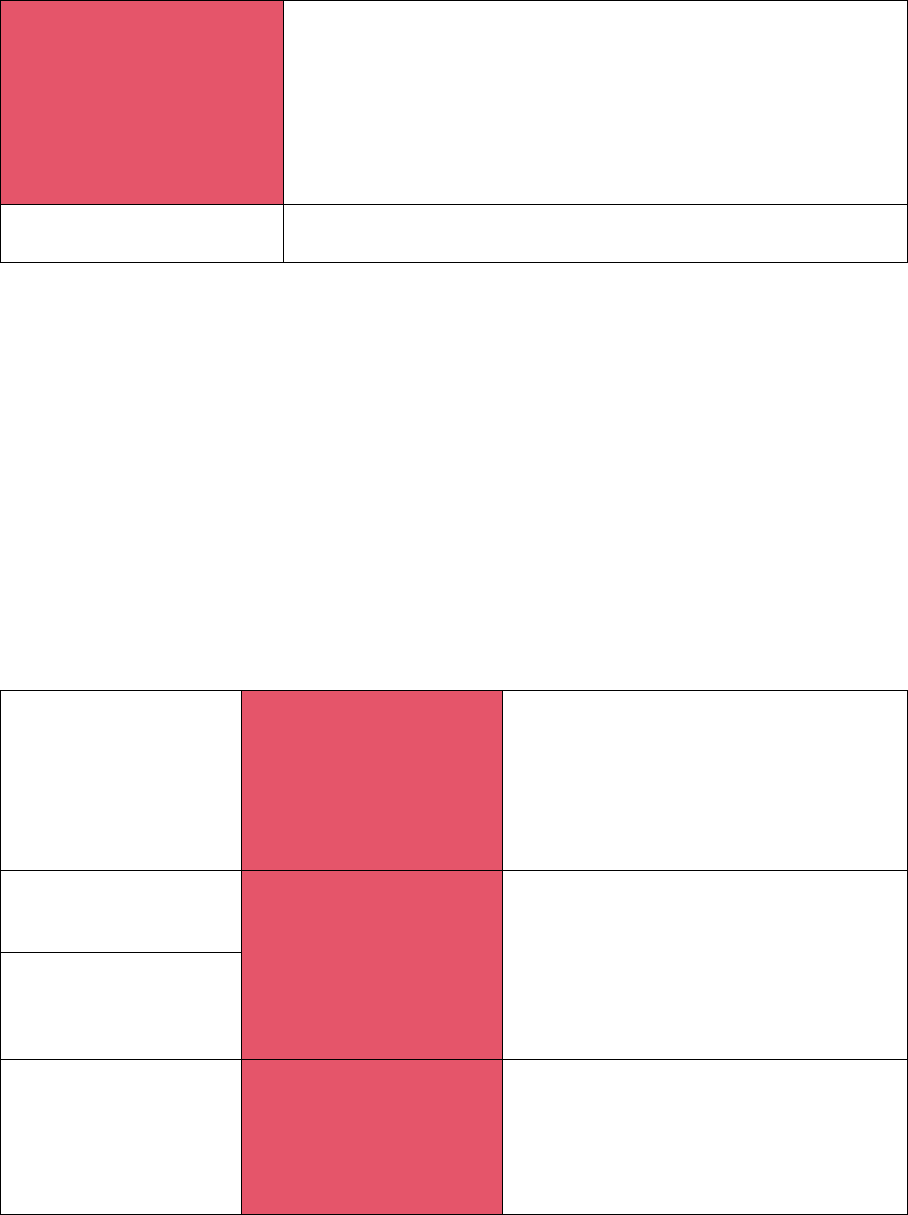
36
Summary result
No advanced fee modulation
Differentiated fees are applied for different packaging materials, and
within a same material group (e.g. metals and plastics). Fees are calculated
to cover the extra cost of the selective collection of packaging waste, and
only depend on the type of material. No reference is made to any of the
criteria for assessment of advanced fee modulation. However, criteria for
advanced fee modulation taking into account all four assessment criteria
are proposed in a draft version of the new Spanish packaging legislation
currently in process.
Robustness of the underlying
information
Information retrieved from the Spanish packaging PRO websites
SRF P-5.3 Material specific EPR assessment
The material specific assessment is based on a combination of the coverage of the material-specific
EPR schemes and the use of fee modulation for the specific packaging material. The assessment takes
the different situations for different types of materials into account: Plastics packaging is the
packaging material that is the most difficult to recycle out of the packaging materials targeted by the
Packaging and Packaging Waste Directive. Fee modulation therefore plays a larger role for plastic
packaging than for the other materials and is therefore rated differently from paper/cardboard,
ferrous metals, aluminium and glass. The methodology foresees a green score for plastics packaging
only if all four fee modulation assessment criteria mentioned above are met. On the other hand,
wooden packaging is mainly generated by commercial and industrial sources and fee modulation is
less relevant, therefore the methodology only relies on EPR schemes for wooden packaging from
commercial and industrial sources.
Summary result
SRF P-5.3.1
EPR scheme for paper and
cardboard packaging
waste
EPR scheme covering only
household packaging
Spain has an EPR scheme in place covering
household paper and cardboard packaging, as
well as EPR schemes covering agricultural
packaging of all packaging material types. In
the future, the application of the EPR will be
extended to commercial and industrial
packaging.
SRF P-5.3.2
EPR scheme for ferrous
metals packaging waste
EPR scheme covering only
household packaging
Spain has an EPR scheme in place covering
household metal packaging, as well as EPR
schemes covering agricultural packaging of all
packaging material types. In the future, the
application of the EPR will be extended to
commercial and industrial packaging.
SRF P-5.3.3
EPR scheme for aluminium
packaging waste
SRF P-5.3.4
EPR scheme for glass
packaging waste
EPR scheme covering only
household packaging
Spain has an EPR scheme in place covering
household glass packaging, as well as EPR
schemes covering agricultural packaging of all
packaging material types. In the future, the
application of the EPR will be extended to
commercial and industrial packaging.

37
SRF P-5.3.5
EPR scheme for plastic
packaging waste
EPR scheme covering only
household packaging
Spain has an EPR scheme in place covering
household plastic packaging, as well as EPR
schemes covering agricultural packaging of all
packaging material types. In the future, the
application of the EPR will be extended to
commercial and industrial packaging.
SRF P-5.3.6
EPR scheme for Wooden
packaging waste
No EPR scheme
Spain has no EPR scheme in place covering
wooden household packaging. EPR schemes
covering agricultural packaging consider all
packaging material types. In the future, the
application of the EPR will be extended to
commercial and industrial packaging.
Robustness of the underlying information
Credible information received from the
Spanish authorities through the EEA-
ETC/WMGE questionnaire.

38
2.3 Target on landfill of municipal waste
2.3.1 Current situation and past trends
SRF LF-1.1: Distance to target
The Landfill Directive (1999/31/EC), as amended by Directive 2018/850, sets a target to reduce, by
2035, the amount of municipal waste landfilled to 10 % or less of the total amount of municipal waste
generated (by weight).
Data to show the current rate of landfilling in line with the reporting rules will only be reported by
mid-2022. Therefore, this analysis calculates the landfilling rate based on the current Eurostat dataset
Municipal waste by waste management operations [env_wasmun]; by dividing the amount of
landfilled waste by the total amount of waste generated. The overall landfilling rate of Spain was 52.0
% in 2020. About 74 % of all MSW that is landfilled in Spain, consists of reject from various waste
treatment processes; the remaining 26 % is residual MSW that is directly landfilled without any pre-
treatment (Ministry for the Ecological Transition and the Demographic Challenge, 2021).
Summary result
Distance to target > 20
percentage points, or no data
reported
The distance to the target is 42.0 percentage points with a landfilling rate of
52.0 % in 2020.
Robustness of the underlying
information
The data is derived from Eurostat and is considered to be rather robust.
However, the reported landfill rate might increase once the new calculation
rules laid down in the Commission Implementing Decision (EU) 2019/1885 will
be applied. Based on the available information, it is currently not possible to
quantify the impact of the new calculation rules on the landfill rate.
SRF LF-1.2: Past trend in municipal solid waste landfill rate
Over the past five years, the overall landfilling rate of Spain has not changed substantially (Figure 2.4).
Figure 2.4 Landfilling in Spain between 2016 and 2020, in percentage
Source: Eurostat (2022b)
Note: Data for 2020 are flagged as estimates.
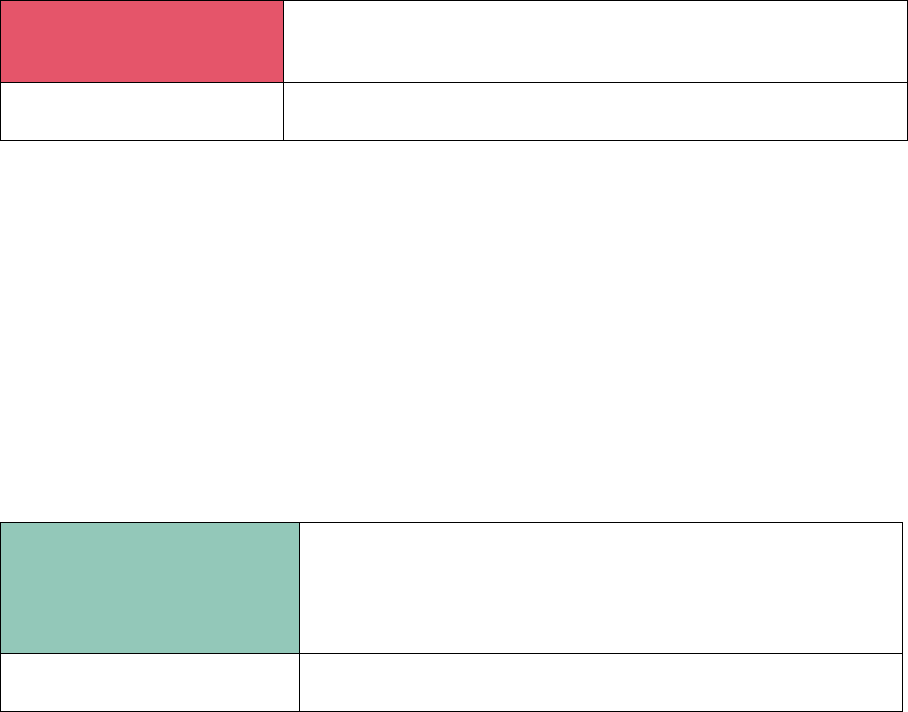
39
Summary result
Landfill rate in 2020 > 25% and
decrease in last 5 years < 15
percentage points
The landfilling rate in 2020 was 52.0 % with only a minor change over the
past five years
Robustness of the underlying
information
There are no breaks in the time series data.
SRF LF-1.3: Diversion of biodegradable municipal waste from landfill
According to Art. 5(2c) of the EU Landfill Directive, Member States had to ensure that by 2016,
biodegradable municipal waste going to landfills is reduced to 35 % of the total amount (by weight) of
biodegradable municipal waste produced in 1995 or the latest year before 1995 for which
standardised Eurostat data is available
Spain generated about 12 million tonnes of biodegradable municipal waste in the reference year. Of
this weight, 32 % was still landfilled in 2016, so reaching the target of 35 %. Later, further reductions
were reported, with 31 % in 2018 and 29 % in 2019 (EC, 2022). This reduction was mainly achieved
through pre-treatment of mixed municipal waste in MBT plants.
Summary result
Target for reducing the amount of
biodegradable municipal waste
(BMW) landfilled to 35% of BMW
generated in 1995 has been
achieved in 2016
32 % of the reference weight of biodegradable municipal waste for
Spain was landfilled in 2016, so the target has been reached.
Robustness of the underlying
information
Data reported by the Spanish authorities to the European Commission.

40
3 Conclusion
This risk assessment indicates whether Spain is at risk of not meeting the targets. The ‘total risk’
categorization is the result of the sum of the individual scores of each SRF as described in the previous
chapter, where the assessment of each SRF results in a score of 2 points (green), 1 point (amber) or
0 points (red), depending on the assessment of the SRF. As some SRFs are considered to have a higher
impact on meeting the target, the score of the SRF is multiplied by the defined weight of the SRF. As
some SRFs might not be applicable to Spain, only the SRFs relevant to Spain are taken into account to
define the maximum score. Spain is considered to be ‘not at risk’ if its score is 50 % or more of this
maximum score, and ‘at risk’ if its score is less than 50 % of the maximum score.
3.1 Prospects for meeting the recycling target for municipal solid waste
23%
of maximum score
Based on the provided information and the analysis done, it is
concluded that Spain is at risk for not meeting the MSW recycling
target in 2025.
Current situation and past
trends:
Based on currently available data Spain’s recycling rate lies at 36.4 %,
18.6 percentage points below the 2025 target. If 2019 data is used for
the assessment given that the 2020 data is still an estimate, the
distance to the target would be 17 percentage points. Considering
however the impact of the new calculation rules, it is likely that the
recycling rate was even lower. The recycling rate has only slightly
improved over the last five years, so the pace of improvement needs
speeding up considerably.
Legal instruments:
The new Law on Waste and Contaminated Soil for a Circular Economy
transposed the modifications introduced by Directive (EU) 2018/851
on waste, was approved by the Spanish Congress in March 2022,
almost two years after the deadline of 5
th
of July 2020.,
Economic instruments:
At current, only 16 out of 9 000 municipalities had PAYT schemes in
place, so little or no incentives are provided for the citizens to prevent
(residual) waste generation.
The new Law on Waste and Contaminated Soil for a Circular Economy
introduces elevated national landfill and incineration taxes, however
without escalator mechanisms. Regional authorities (autonomous
communities) can increase these taxes in their respective regions.
Separate collection systems:
A mix of high-density bring point and door-to-door collection systems
are used with very high coverage across the country for paper and
cardboard, metals, plastics and glass, but limited to packaging waste
only for metals and plastics.
Currently, not more than 10 % of the organic fraction of MSW
generated in Spain is separately collected. At the same time, bio-
waste accounts for 47.2 % of the total volume of mixed residual waste
collected in Spain.
Door-to-door collection of bio-waste is limited to a few Autonomous
Communities and municipalities. The new Law on Waste and
Contaminated Soil for a Circular Economy establishes separate

41
collection of biowaste to be nation-wide as from 31 December 2023,
but there seem to be no national requirements on the coverage and
convenience levels of the collection systems, the implementation of
which falls under the responsibility of the local authorities.
Extended producer
responsibility:
Differentiated fees are applied for different packaging materials in
order to cover the extra cost of the selective collection of packaging
waste, but they lack granularity and only depend on the type of
material.
Bio-waste treatment capacity
and quality management:
If the separate collection of organic waste could be increased
substantially over the next years, there seems to be a considerable
lack of capacity to treat a significant part of the 8.3 million tons of
potentially generated bio-waste that is currently being collected as
part of the residual, mixed MSW. A more comprehensive assessment
of the corresponding needs would require the provision of additional
quantitative information on existing, planned or projected biowaste
treatment capacity. Through the 2021 Recovery and Resilience Plan
for Spain, earmarked funding has been made available for extending
treatment capacity for bio-waste.
3.2 Prospects for meeting the recycling target for packaging waste
59 %
of maximum score
Based on the provided information and the analysis done, it is concluded
that Spain is not at risk for not meeting the 65 % recycling target for
total packaging waste in 2025
47 % of maximum score
Paper and cardboard packaging
At risk
67 % of maximum score
Ferrous metals packaging
Not at risk
44 % of maximum score
Aluminium packaging
At risk
63 % of maximum score
Glass packaging
Not at risk
41 % of maximum score
Plastics packaging
At risk
63 % of maximum score
Wooden packaging
Not a risk
Current situation and past
trends:
Spain reports recycling rates for all packaging materials above the
targets, except for paper and cardboard and aluminium. When the
impact of the application of the new reporting rules is estimated, the
distance to the target for plastics, aluminium and paper and cardboard
packaging lies above 5 percentage points. There are however some
challenges to overcome in order to maintain this situation.
An unfortunate trend is observed with regard to the recycling rate for
paper and cardboard packaging, which has decreased by 4 percentage
points over the last five years.

42
It is possible there is some degree of underreporting of the generated
packaging waste, related to the use of industry declarations to obtain
data on packaging waste generated for packaging other than glass, while
no general estimates are used to improve coverage of data on packaging
waste generated.
Legal instruments:
The revised Packaging and Packaging Waste Directive has not been fully
transposed into national law yet.
The responsibility for reaching the targets is set on PROs. Objectives and
targets are set in Royal Decrees, per material type. The new Law on
Waste and Contaminated Soil for a Circular Economy updates the
existing sanctioning regime.
Under current legislation, the obligation of separate collection also
applies to non-household packaging waste, of all material types. At
present, this obligation is the responsibility of the final holder of the
packaging waste. Under the new Law on Waste and Contaminated Soil
for a Circular Economy, all kinds of packaging, including industrial and
commercial packaging, will however also be mandatorily covered by
extended producer responsibility (EPR) schemes, whereas such coverage
now is only mandatory for agricultural plant protection products
packaging, of all material types, and voluntary for all other.
Economic instruments:
No DRS systems are in place in Spain. A DRS for single use plastic bottles
will be introduced if the 2023 or 2027 objectives as set in the new Law
on Waste and Contaminated Soil for a Circular Economy are not met, and
a draft version of the newly proposed Spanish packaging legislation
establishes that to guarantee the technical, environmental, and
economic viability of the implementation of DRS, cans and cartons for
beverages will be included in the system.
The new Law on Waste and Contaminated Soil for a Circular Economy
also introduces a national tax of 0.45 EUR/kg of non-recycled plastic
contained in non-reusable plastic packaging.
The new Law on Waste and Contaminated Soil for a Circular Economy
introduces elevated national landfill and incineration taxes, however
without escalator mechanisms. Regional authorities (autonomous
communities) can increase these taxes in their respective regions.
Separate collection
systems:
High convenience collection systems have been rolled out over the
whole territory for household packaging. For industrial and commercial
packaging waste, the separate collection obligations currently fall on the
final holder of the packaging waste. The initial producer or other holder
of non-hazardous commercial waste must also separate paper, metals,
plastic and glass waste at source.

43
Extended producer
responsibility:
The PRO’s for cans, plastic, beverage cartons, paper and carboard, and
glass packaging only cover household packaging. EPR schemes that cover
non-household sources are limited to medicine containers and
agricultural plant protection and fertilizer products packaging, of all
packaging material types. In the future, the application of the EPR will be
extended to commercial and industrial packaging.
3.3 Prospects of meeting the landfill of municipal waste target
14 %
of maximum score
Based on the provided information and the analysis done, it is concluded
that Spain is at risk for not meeting the 2035 target to reduce the
amount of municipal waste landfilled to 10 % or less of the total
amount of municipal waste generated.
Current situation and past
trends:
Based on currently available data, Spain’s landfilling rate lies at 52 %, so
the distance to the 2025 target is 42 percentage points. Very little
progress in reducing the landfill rate was made over the past 5 years.
Diversion of biodegradable
municipal waste from
landfill:
32 % of the reference weight of biodegradable municipal waste for Spain
was landfilled in 2016, decreasing to 29 % in 2019. This was mainly
achieved by pre-treatment of mixed municipal waste.

44
List of abbreviations
Abbreviation
Name
BMW
Biodegradable Municipal Waste
CAS
Civic Amenity Site
DRDPPW
Draft Royal Decree on Packaging and Packaging Waste
DRS
Deposit Return System
EC
European Commission
EEA
European Environment Agency
Eionet
European Environmental Information and Observation Network
EPR
Extended producer responsibility
ETC/CE
European Topic Centre on Circular Economy and resource use
ETC/WMGE
European Topic Center / Waste and Materials in a Green Economy
HDPE
High-density polyethylene
LDPE
Low-density polyethylene
MBT
Mechanical biological treatment
MS
Member state
MSW
Municipal solid waste
NWMP
The National Waste Management Plan
PAYT
Pay-as-you-throw
PET
Polyethylene terephthalate
PPWD
Packaging and Packaging Waste Directive
PRO
Producer Responsibility Organisation
RR
Recycling rate
SRF
Success and risk factor
TOC
Total organic carbon
VAT
Value Added Tax
WEEE
Waste Electric and Electronic Equipment
WFD
Waste Framework Directive
45
References
ANEABE Aguas Minerales de España, 2022, ‘Europa recibe el texto del Proyecto de Real Decreto de
Envases’, Europa recibe el texto del Proyecto de Real Decreto de Envases
(https://aneabe.com/actualidad/europa-recibe-el-texto-del-proyecto-de-real-decreto-de-envases/)
accessed 16 June 2022.
Boletín Oficial de las Cortes Generales, Senado, 2022, Proyecto de Ley de residuos y suelos
contaminados para una economía circular. (621/000042).
Consellería de Agricultura, Medio Ambiente, Cambio Climático y Desarrollo Rural, 2019, Decreto
55/2019 (8536).
COWI, et al., 2019, Study on investment needs in the waste sector and on the financing of municipal
waste management in Member States, Publications Office of the European Union, Luxembourg
(https://op.europa.eu/en/publication-detail/-/publication/4d5f8355-bcad-11e9-9d01-
01aa75ed71a1/language-en/format-PDF/source-218145547) accessed 7 June 2021.
de Miguel, C. and Fernández, B., 2021, ‘The Environment and Climate Change Law Review: Spain’, in:
The Environment and Climate Change Law Review - 5th Edition, , p. 296.
Dirección General de Calidad y Evaluación Ambiental y Medio Natural, 2015, Plan Estatal Marco de
Gestión de Residuos (PEMAR) 2016-2022, (https://www.miteco.gob.es/es/calidad-y-evaluacion-
ambiental/planes-y-estrategias/pemaraprobado6noviembrecondae_tcm30-170428.pdf) accessed 16
September 2021, Ministerio de Agricultura, Alimentación y Medio Ambiente.
EC, 2018a, COMMISSION STAFF WORKING DOCUMENT The early warning report for Spain
Accompanying the document REPORT FROM THE COMMISSION TO THE EUROPEAN PARLIAMENT, THE
COUNCIL, THE EUROPEAN ECONOMIC AND SOCIAL COMMITTEE AND THE COMMITTEE OF THE
REGIONS on the implementation of EU waste legislation, including the early warning report for
Member States at risk of missing the 2020 preparation for re-use/recycling target on municipal waste
(https://op.europa.eu/en/publication-detail/-/publication/264aac11-c004-11e8-9893-
01aa75ed71a1/language-en/format-PDF/source-196827447).
EC, 2018b, Report from the Commission to the European Parliament, the Council, the European
Economic and Social Committee and the Committee of the Regions on the implementation of EU
waste legislation, including the early warning report for Member States at risk of missing the 2020
preparation for re-use/recycling target on municipal waste (COM(2018) 656 final).
EC, 2019, Commission Implementing Decision (EU) 2019/665 of 17 April 2019 amending Decision
2005/270/EC establishing the formats relating to the database system pursuant to European
Parliament and Council Directive 94/62/EC on packaging and packaging waste (notified under
document C(2019) 2805) (Text with EEA relevance.) (OJ L 112, 26.4.2019, p. 26–46).
EC, 2022, Data on the landfill of biodegradable municipal waste, 2018-2019, provided to the EEA by
the European Commission, status 14/01/22.
Ecoembes, 2021, ‘Reciclaje de envases por CC.AA.’, Datos de reciclaje en España
(https://www.ecoembes.com/baroeco/reciclaje-envases-ccaa.php) accessed 18 May 2021.
46
EEA, 2020, Bio-waste in Europe — turning challenges into opportunities, EEA report No 4/2020,
European Environment Agency (https://www.eea.europa.eu/publications/bio-waste-in-europe)
accessed 20 June 2020.
Esteban-Altabella, J., et al., 2020, ‘Behavior of Rejects from a Biological-Mechanical Treatment Plant
on the Landfill to Laboratory Scale’, Sustainability, 12(2), 499.
ETC/CE & ETC/WMGE, 2022, Methodology for the Early Warning assessment related to certain waste
targets, ETC/CE Report, European Topic Centre on Circular Economy and resource use
(https://www.eionet.europa.eu/etcs/etc-ce/products/etc-ce-products/methodology-for-the-early-
warning-assessment-related-to-certain-waste-targets).
ETC/WMGE, 2021, Methodology for the Early warning assessment related to certain waste targets,
ETC/WMGE Working Paper, European Topic Centre on Waste and Materials in a Green Economy
(https://www.eionet.europa.eu/etcs/etc-wmge/products/etc-reports/methodology-for-the-early-
warning-assessment-related-to-certain-waste-targets) accessed 29 April 2021.
EU, 2018, Directive (EU) 2018/852 of the European Parliament and of the Council of 30 May 2018
amending Directive 94/62/EC on packaging and packaging waste (text with EEA relevance) (OJ L 150,
14.6.2018, p. 141-154).
Eunomia, 2018, Study to Identify Member States at Risk of Non-Compliance with the 2020 Target of
the Waste Framework Directive and to Follow-up Phase 1 and 2 of the Compliance Promotion Exercise
- Early Warning Report: Croatia.
European Commission, 2019, The Environmental Implementation Review 2019 - Country Report Spain.
European Commission, 2021, ‘NextGenerationEU: European Commission endorses Spain’s €69.5
billion recovery and resilience plan’
(https://ec.europa.eu/commission/presscorner/detail/en/ip_21_2987) accessed 16 September 2021.
European Environmental Bureau, 2020, #NoTimeToWaste - Member States delay meeting the
inevitable targets, Brussels.
Eurostat, 2017, Country specific notes on municipal waste data - Last update September 2017,
(https://ec.europa.eu/eurostat/documents/342366/351758/Footnotes-MW/d0579b7d-a998-47d1-
b983-fa384509da1a).
Eurostat, 2020, ‘Comparative price levels of consumer goods and services’
(https://ec.europa.eu/eurostat/statistics-
explained/index.php?title=Comparative_price_levels_of_consumer_goods_and_services) accessed 6
May 2021.
Eurostat, 2021a, ‘Household characteristics by degree of urbanisation (HBS_CAR_T315)’
(https://ec.europa.eu/eurostat/databrowser/view/HBS_CAR_T315__custom_37301/default/table?l
ang=en) accessed 6 May 2021.
Eurostat, 2021b, Quality check report according to Art. 10(3b) of the Packaging and Packaging Waste
Directive for Spain for the reference year 2019.
Eurostat, 2022a, Country-specific notes referring to data on packaging and packaging waste - Revision
March 2022,
47
(https://ec.europa.eu/eurostat/documents/342366/13429143/Country+specific+notes+for+packagi
ng+and+packaging+waste.pdf/59ea2d73-3416-b40b-1771-2eb33e0b8486?t=1648204996107).
Eurostat, 2022b, ‘Municipal waste by waste operations [env_wasmun]’
(https://ec.europa.eu/eurostat/databrowser/view/ENV_WASMUN/default/table) accessed 14
February 2022.
Eurostat, 2022c, ‘Packaging waste by waste management operations [env_waspac]’
(https://ec.europa.eu/eurostat/databrowser/view/ENV_WASPAC__custom_842634/default/table?l
ang=en) accessed 12 March 2022.
Eurostat, 2022d, ‘Recycling rates of packaging waste for monitoring compliance with policy targets,
by type of packaging [env_waspacr]’
(https://appsso.eurostat.ec.europa.eu/nui/show.do?dataset=env_waspacr&lang=en) accessed 12
March 2022.
EXPRA, 2014, The effects of the proposed EU packaging waste policy on waste management practice:
a feasibility study, (https://www.expra.eu/downloads/expra_20141004_f_UGGge.pdf).
Gallardo, A. I., 2014, Estudio de la situación actual de las plantas de tratamiento mecánico‐biológico
en España, Congreso Nacional del Medio Ambiente (CONAMA).
Gobierno de España, 2021, Plan de Recuperación, Transformación y Resiliencia,
(https://www.lamoncloa.gob.es/temas/fondos-recuperacion/Documents/160621-
Plan_Recuperacion_Transformacion_Resiliencia.pdf) accessed 16 September 2021.
Jefatura del Estado, 2022, Ley 7/2022, de 8 de abril, de residuos y suelos contaminados para una
economía circular. (BOE-A-2022-5809).
Junta de Andalucía, 2021, Plan Integral de Residuos de Andalucía - Hacia una Economía Circular en el
Horizonte 2030,
(https://www.juntadeandalucia.es/medioambiente/portal/documents/20151/26992369/2021_10_1
9_PIRec_completo5.pdf/6c1a646a-c293-79ca-c201-a913386b86ce?t=1634807843024) accessed 30
March 2022.
Ministerio de la Presidencia, 2013, Real Decreto 506/2013, de 28 de junio, sobre productos
fertilizantes. (Real Decreto 506/2013).
Ministerio para la Transición Ecológica, nd, Memoria Anual de Generación y Gestión de Residuos -
Residuos de Competencia Municipal. 2019, Memoria Anual de Generación y Gestión de Residuos,
Ministerio para la Transición Ecológica (https://www.miteco.gob.es/es/calidad-y-evaluacion-
ambiental/publicaciones/memoriaanual2019generacionygestionresiduosrescompetenciamunicipal_
tcm30-534462.pdf) accessed 20 June 2022.
Ministerio para la Transición Ecológica y el Reto Demográfico, 2021, Proyecto de Real Decreto, de
Envases y Residuos de Envases - Versión de 28 de septiembre de 2021.
Ministerio para la Transición Ecológica y el Reto Demográfico, 2022, Proyecto de Real Decreto de
Envases y Residuos de Envases (2022/0325/E - S10E).
Ministerio para la Transición Ecológica y el Reto Demográfico, No date, España Circular 2030 -
Estrategia Española de Economía Circular, (https://www.miteco.gob.es/es/calidad-y-evaluacion-
48
ambiental/temas/economia-circular/espanacircular2030_def1_tcm30-509532_mod_tcm30-
509532.pdf) accessed 10 June 2022.
Ministry for the Ecological Transition and the Demographic Challenge, 2021, Questionnaire to
Member States for providing information into the Early Warning analyses - Spain, and comments to
the first draft assessment.
MITECO, 2021, ‘El MITECO abre a información pública el Real Decreto de envases y residuos, para
impulsar la prevención y la reutilización, y mejorar el reciclado posterior’
(https://www.lamoncloa.gob.es/serviciosdeprensa/notasprensa/transicion-
ecologica/Paginas/2021/280921-envases_residuos.aspx) accessed 4 July 2022.
MITECO, 2022, Information and comments provided to the EEA by the Ministry for the Ecological
Transition and the Demographic Challenge (MITECO) during the review of this assessment, by e-mail
dated 29 April 2022.
MITECO, nd, Memoria Anual De Generación Y Gestión De Residuos 2018, Ministerio para la Transición
Ecológica y el Reto Demográfico.
Puyuelo, B., et al., 2019, ‘Quality assessment of composts officially registered as organic fertilisers in
Spain’, Spanish Journal of Agricultural Research.
Zero Waste Europe, B. industries consortium, 2020, Bio-waste generation in the EU: Current capture
levels and future potential.
2016, Plan Integrado de Gestión de Residuos de Castilla-La Mancha,
(https://www.castillalamancha.es/sites/default/files/documentos/pdf/20210406/20210405pigr.pdf)
, Castilla - La Mancha.
49
Annex 1 Implementation of previous early
warning recommendations
Recommendations on separate collection
1) Introduction of compulsory separate collection of food and garden waste in national legislation,
accompanied by a set of qualitative criteria, such as minimum collection rates and minimum collection
quality standards (e.g. minimum frequency of collection or maximum plastic contamination rate).
The new Law 7/2022 on Waste and Contaminated Soil for a Circular Economy includes the extension
of the obligation of separate collection of bio-waste to the entire national territory. Furthermore, a
maximum percentage was set for non-targeted materials in separately collected biowaste, of 20%
from 2022 and 15% from 2027, and the possibility was opened for establishing maximum impurity
levels for other waste fractions too. In case of exceedance, legal sanctions will be applicable.
2) Introduction of binding separate collection targets at municipal level, with penalties for non-
compliance to enforce them
The State Waste Management Framework Plan 2016-2022 (PEMAR) transferred the obligation to fulfil
the collection targets to the regional authorities (autonomous communities). This obligation has been
reinforced in the text of the new Law 7/2022 on Waste and Contaminated Soil for a Circular Economy,
which also establishes that the autonomous communities (CCAA) will be entitled to determine the
contribution of local authorities to the achievement of these targets. Failure to comply with the
provisions of the law is subject to specified sanctions.
Recommendations on economic instruments
3) Introduction of mandatory municipal waste charges for households, accompanied by an indication
of the minimum cost recovery level for waste management. These financial resources should support
the necessary changes in waste collection and treatment.
In the case of municipal waste management costs, the new Law 7/2022 on Waste and Contaminated
Soil for a Circular Economy states in its article 13 (translated) that ‘In the case of waste management
costs of local competence, […] local entities will establish, within three years from the entry into force
of this law, a rate or, where appropriate, a non-tax, specific, differentiated and non-deficit public
patrimonial benefit, which allows the implementation of payment systems for generation and that
reflects the real cost, direct or indirect, of the waste collection, transport and treatment operations’ As
of April 2022, this recommendation is considered as implemented.
4) Introduction of a harmonised taxation scheme for waste disposal (i.e. landfill and incineration)
operating across all Autonomous Communities.
The new Law on Waste and Contaminated Soil for a Circular Economy introduces a harmonized tax on
landfilling and incineration, applicable throughout the national territory.
Recommendations on monitoring
5) Publication by the Ministry of Agriculture, Fishing, Food and Environment of an annual review of
municipal waste management in each region, including:
• regional performance in terms of recycling rates and distance to target;
• operational measures implemented in the waste sector;
• investments in the waste sector;
• economic and legal instruments put in place by the regions.
50
The 2019 annual report published on the website of the Ministry (Ministerio para la Transición
Ecológica, nd), provides figures on the regional performance in terms of separate collection, recycling
rates, and distance to target, but does not include information on operational measures, investments
and economic and legal instruments put in place by the regions. Therefore, this recommendation is
considered as partially implemented.
6) Collection of the information by the Ministry on commercial waste that is privately managed and
could contribute to the overall municipal waste recycling rate.
Currently, regional authorities with waste management competences are in process to collect
information on commercial waste. An electronic information system on waste, harmonized at national
level, is under development, and would include information on privately managed commercial waste.
Therefore, the recommendation is considered as in process of implementation.
Recommendations on technical support to municipalities
7) Development of a system at national level that provides technical support for municipalities,
specifically in the following areas:
a) choosing collection services;
b) service procurement;
c) service management;
d) communication campaigns;
coupled with active sharing of good ideas and practices that can improve efficiency in terms of cost
reduction and improvement in performance.
Since 2017, the European Commission has provided expertise to help design reform projects in
Member States through the Structural Reform Support Programme (SRSP). As of 2021, the Technical
Support Instrument (TSI), its successor, continues to support reforms with an emphasis on the green
and digital transitions. The TSI also supports the preparation and implementation of Member States’
Recovery and Resilience Plans (European Commission, 2021). In this context, Spain has been granted
funding for an initiative that supports the implementation of improved recycling collection and
treatment systems at the municipal level.
In addition, various studies have been carried out on specific issues that may provide technical support
to municipalities, such as the following:
- Waste management systems in island areas;
- Waste management systems in rural areas;
- Collection and recycling of waste paper generated in Universities:
Recommendations on communication and awareness-raising programmes
8) Development of a set of national communications materials addressed to the public for use at local
level, with clear and consistent messages. These materials should be used as part of awareness-raising
campaigns, in leaflets, and at civic amenity sites.
A single example of a national communication material for awareness raising was provided, referring
to a poster on the measures to reduce the use of single use plastic bags. National awareness
campaigns on plastic waste and on circular economy, the latter including recommendations for
improving source separation of waste, are being planned.
51
Annex 2 Detailed scoring of success and risk
factors
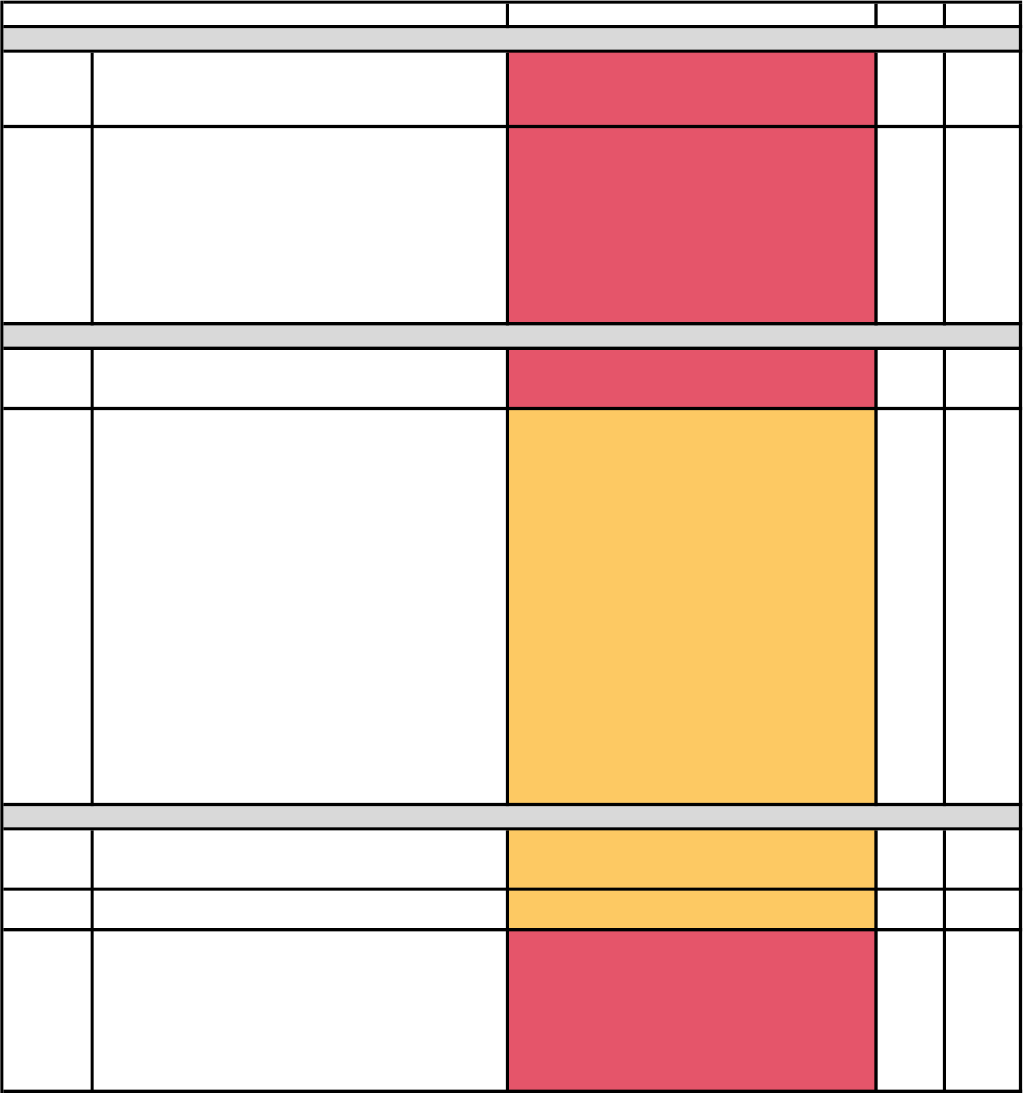
Assessment sheet - Recycling target for municipal waste
MS Spain
Date Jun-22
Assessment result Weight Score
MSWR-1.1 Distance to target
Distance to target > 15 percentage points or no data
reported
5 0
MSWR-1.2 Past trends in municipal solid waste recycling rate
RR < 45% and increase in last
5 years < 10 percentage points
1 0
MSWR-2.1
Timely transposition of the revised WFD into national
law
Transposition with delay of > 12 months, or no full
transposition yet
1 0
MSWR-2.2
Clearly defined responsibilities for meeting the targets
and support and enforcement mechanisms
Clearly defined responsibilities and good set of support
tools but weak/no enforcement mechanisms for
meeting the recycling targets
OR
Unclear responsibilities but clearly defined
enforcement mechanisms and a good set of support
tools for meeting the recycling targets
OR
Clearly defined responsibilities and enforcement
mechanisms but no/weak support tools for meeting the
recycling targets
1 1
MSWR-3.1
Taxes and/or ban for landfilling residual or biodegradable
waste
Yes, taxes > 30 EUR/t*
1 1
MSWR-3.2 Taxes on municipal waste incineration
Taxes > 7 EUR/t*, but without escalator
1 1
MSWR-3.3 Pay-as-you-throw (PAYT) system
No or less than 50% of the population covered by PAYT
1 0
Legal instruments
Economic instruments
SRF
Current situation and past trends
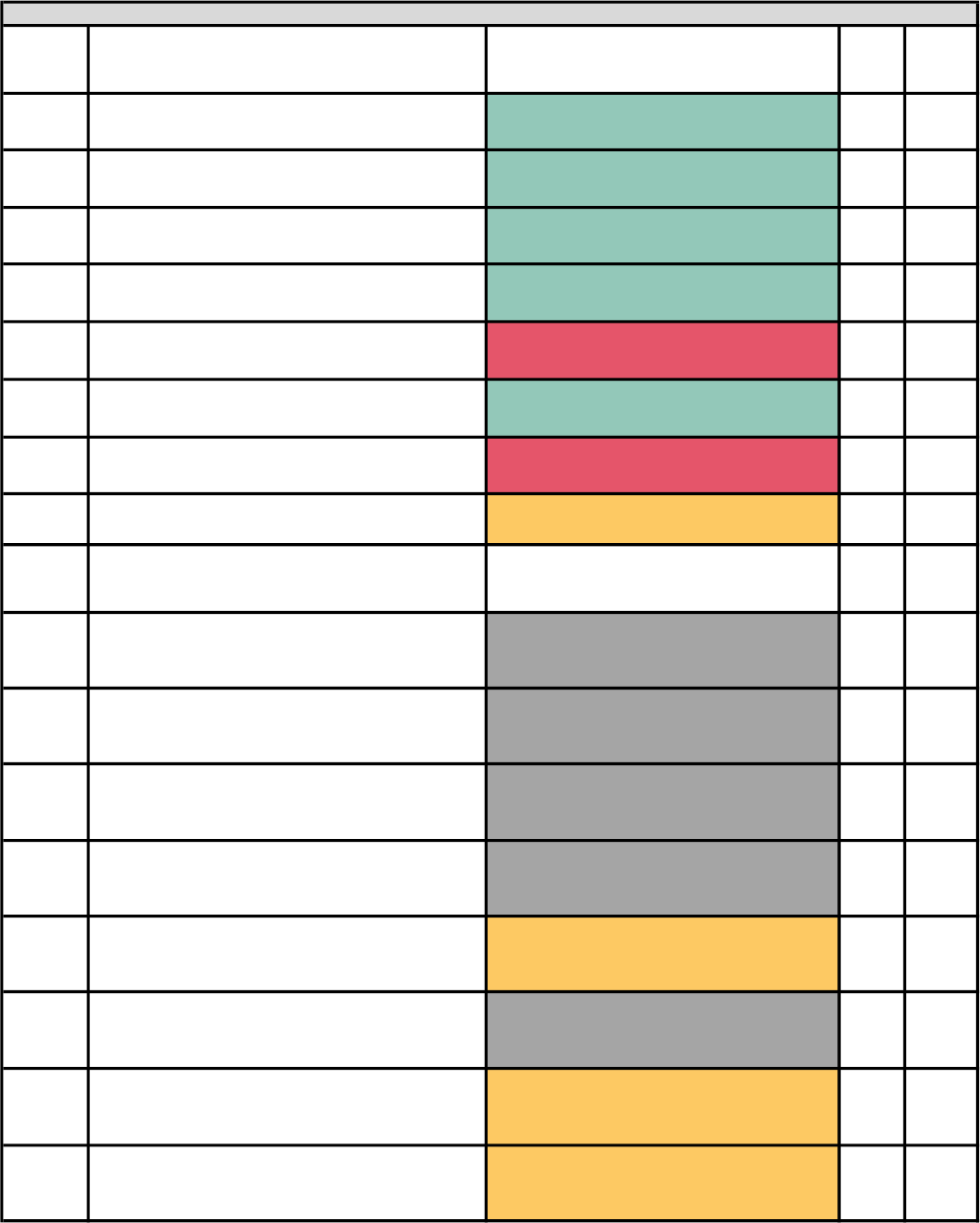
MSWR-4.1
Convenience and coverage of separate collection
systems for the different household waste fractions
Paper and cardboard
A high share of the population is covered by high
convenience collection services
0.46 0.92
Metals
A high share of the population is covered by high
convenience collection services
0.08 0.16
Plastics
A high share of the population is covered by high
convenience collection services
0.28 0.56
Glass
A high share of the population is covered by high
convenience collection services
0.18 0.36
Bio-waste
A low share of the population is covered by high
convenience collection services
0.84 0
Wood
A high share of the population is covered by high
convenience collection services
0.06 0.12
Textiles
A low share of the population is covered by high
convenience collection services
0.06 0
WEEE
Medium convenience collection services dominate
0.04 0.04
MSWR-4.2
Firm plans to improve the convenience and coverage of
separate collection systems for the different household
waste fractions
Paper and cardboard
N/A (for countries in which a very high share of the
population is already covered by high convenience
collection services)
0.23 0
Metals
N/A (for countries in which a very high share of the
population is already covered by high convenience
collection services)
0.04 0
Plastics
N/A (for countries in which a very high share of the
population is already covered by high convenience
collection services)
0.14 0
Glass
N/A (for countries in which a very high share of the
population is already covered by high convenience
collection services)
0.09 0
Bio-waste
There are plans to improve the collection service but
unclear plan for implementation
0.42 0.42
Wood
N/A (for countries in which a very high share of the
population is already covered by high convenience
collection services)
0.03 0
Textiles
There are plans to improve the collection service but
unclear plan for implementation
0.03 0.03
WEEE
There are plans to improve the collection service but
unclear plan for implementation
0.02 0.02
Separate collection systems
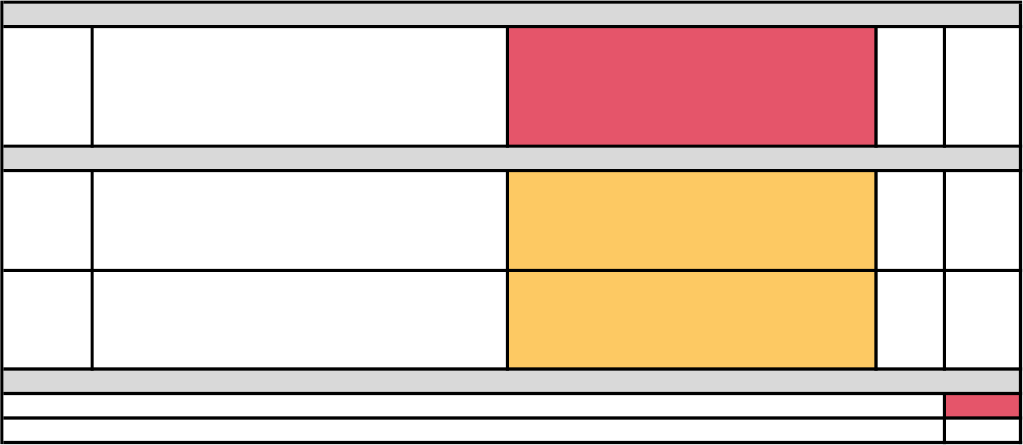
MSWR-5.1 Fee modulation in EPR schemes for packaging
No advanced fee modulation OR fee modulation meets
less than two assessment criteria
1 0
MSWR-6.1 Capacity for the treatment of bio-waste
Bio-waste capacity below 80% of generated municipal
bio-waste but firm plans to close the gap
1 1
MSWR-6.2
Legally binding national standards and Quality
Management System for compost/digistate
Legally binding national standards for
compost/digestate quality but no quality management
system
1 1
7.63
32.94
23%
Maximum score
Extended producer responsibility (EPR) and similar schemes
Bio-waste treatment capacity and quality management
Total score
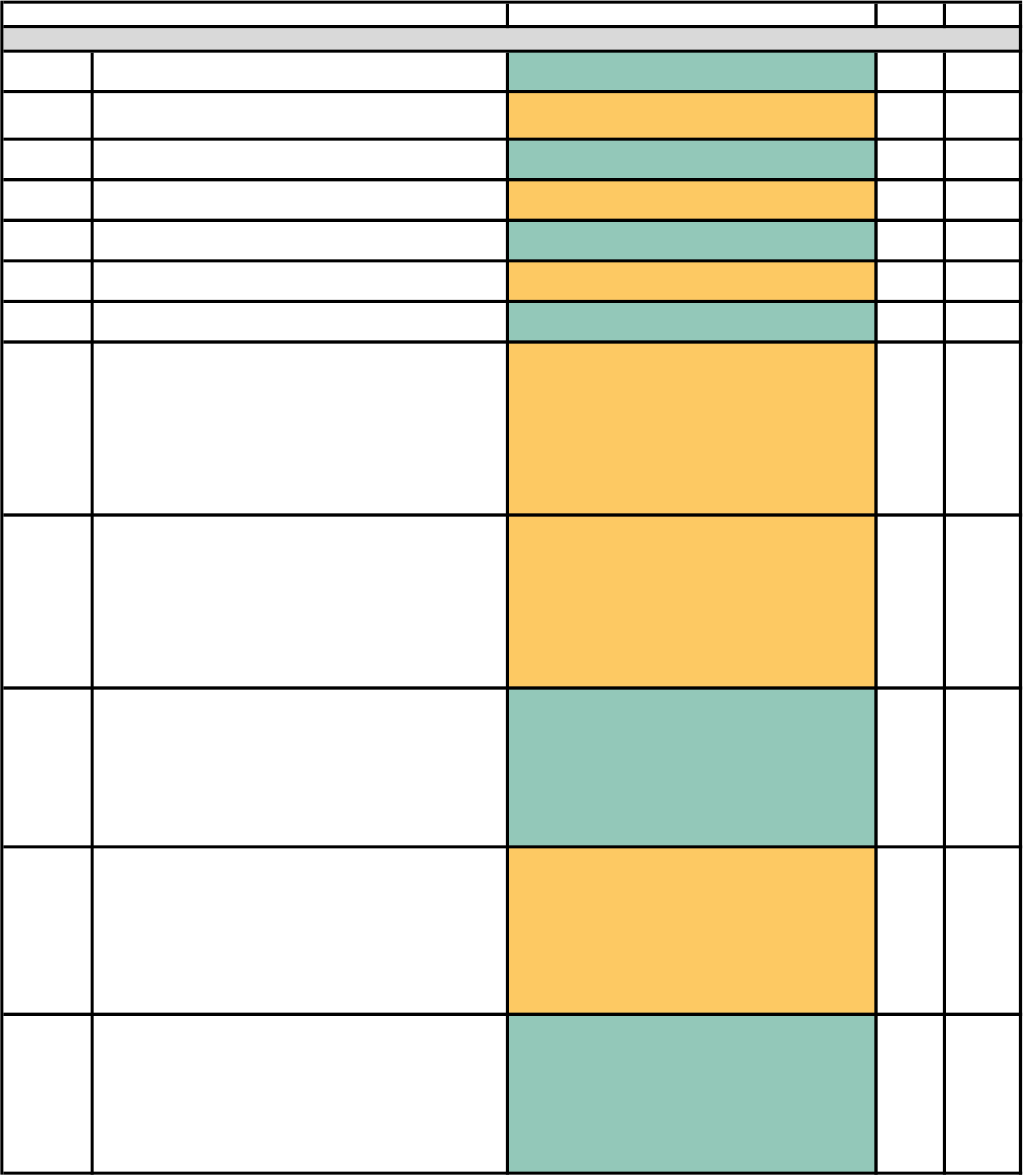
Assessment sheet - Recycling target for packaging waste
MS Spain
Date Jun-22
Assessment result Weight Score
P-1.1 Distance to target - Overall packaging
< 5 percentage points below target, or target exceeded
5 10
Distance to target - Paper and cardboard packaging
5 - 15 percentage points below target
5 5
Distance to target - Ferrous metals packaging
< 5 percentage points below target, or target exceeded
5 10
Distance to target - Aluminium packaging
5 - 15 percentage points below target
5 5
Distance to target - Glass packaging
< 5 percentage points below target, or target exceeded
5 10
Distance to target - Plastics packaging
5 - 15 percentage points below target
5 5
Distance to target - Wooden packaging
< 5 percentage points below target, or target exceeded
5 10
P-1.2 Past trends in packaging waste recycling rate
RR > 60% and increase in
last 5 years < 5 percentage points,
or
RR > 55%, and increase in
last 5 years < 10 percentage points,
or
RR < 55% and increase in
last 5 years > 10 percentage points
1 1
Past trends in paper and cardboard packaging recycling
RR > 70% and increase in
last 5 years < 5 percentage points,
or
RR > 65%, and increase in
last 5 years < 10 percentage points,
or
RR < 65% and increase in
last 5 years > 10 percentage points
1 1
Past trends in ferrous metals packaging recycling
RR > 65% and increase in
last 5 years > 5 percentage points,
or
RR > 60% and increase in
last 5 years > 10 %,
or
RR > 70%
1 2
Past trends in aluminium packaging recycling
RR > 45% and increase in
last 5 years < 5 percentage points,
or
RR > 40%, and increase in
last 5 years < 10 percentage points,
or
RR < 40% and increase in
last 5 years > 10 percentage points
1 1
Past trends in glass packaging recycling
RR > 65% and increase in
last 5 years > 5 percentage points,
or
RR > 60% and increase in
last 5 years > 10 %,
or
RR > 70%
1 2
SRF
Current situation and past trends
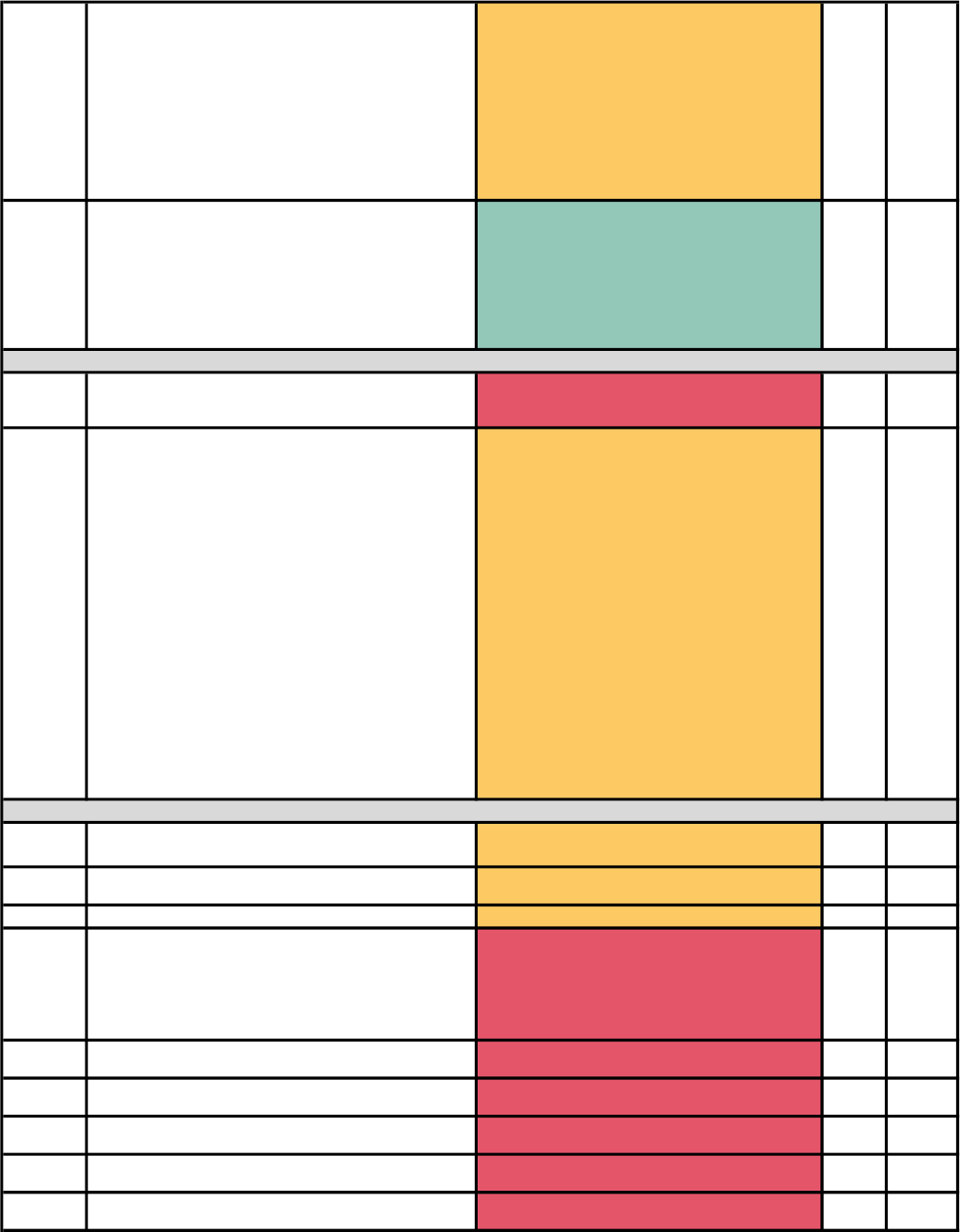
Past trends in plastic packaging recycling
RR > 45% and increase in
last 5 years < 5 percentage points,
or
RR > 40%, and increase in
last 5 years < 10 percentage points,
or
RR < 40% and increase in
last 5 years > 10 percentage points
1 1
Past trends in wooden packaging recycling
RR > 20% and increase in
last 5 years > 5 percentage points,
or
RR > 15% and increase in
last 5 years > 10 %,
or
RR > 25%
1 2
P-2.1
Timely transposition of the revised Packaging and
Packaging Waste Directive into national law
Transposition with delay of > 12 months, or no full
transposition yet
1 0
P-2.2
Clearly defined responsibilities for meeting the targets
and support and enforcement mechanisms
Clearly defined responsibilities and good set of support
tools but weak/no enforcement mechanisms for
meeting the recycling targets
OR
Unclear responsibilities but clearly defined
enforcement mechanisms and a good set of support
tools for meeting the recycling targets
OR
Clearly defined responsibilities and enforcement
mechanisms but no/weak support tools for meeting the
recycling targets
1 1
P-3.1
Taxes and/or ban for landfilling residual or biodegradable
waste
Taxes > 30 EUR/t*
1 1
P-3.2 Taxes on municipal waste incineration
Taxes > 7 EUR/t*
1 1
P-3.3 Packaging taxes
Limited packaging tax
1 1
P-3.4 Pay-as-you-throw (PAYT) system
No or less than 50% of the population covered by PAYT
1 0
P-3.5 Deposit-return systems for aluminium drink cans
No or voluntary DRS for some drink cans
1 0
Deposit-return systems for glass drink bottles
No or voluntary DRS for some drink bottles
1 0
Deposit-return systems plastic drink bottles
No or voluntary DRS for some drink bottles
1 0
Deposit-return systems for plastic crates
No or voluntary DRS for some plastic crates
1 0
Deposit-return systems for wooden packaging
No or voluntary DRS for some wooden packaging
1 0
Legal instruments
Economic instruments

P-4.1
Convenience and coverage of separate collection
systems for the different packaging waste fractions
Paper and cardboard packaging (household)
A high share of the population is covered by high
convenience collection services
1 2
Paper and cardboard packaging (non-household)
Separation at source is mandatory for non-household
paper and cardboard packaging waste
1 2
Ferrous metals packaging (household)
A high share of the population is covered by high
convenience collection services
1 2
Ferrous metals packaging (non-household)
Separation at source is mandatory for non-household
ferrous metals packaging waste
1 2
Aluminium packaging
A high share of the population is covered by high
convenience collection services
2 4
Glass packaging (household)
A high share of population is covered by high
convenience collection services
1 2
Glass packaging (non-household)
Separation at source is mandatory for non-household
glass packaging waste
1 2
Plastics packaging (household)
A high share of the population is covered by high
convenience collection services
1 2
Plastics packaging (non-household)
Separation at source is mandatory for non-household
plastic packaging waste
1 2
Wooden packaging
Separation at source is mandatory for non-household
wooden packaging waste
2 4
P-4.2
Firm plans to improve the convenience and coverage of
separate collection systems for the different packaging
waste fractions
Paper and cardboard (household)
N/A (for countries in which a high share of the
population is already covered by high convenience
collection services)
0.5 0
Paper and cardboard (non-household)
N/A (for countries already having mandatory sorting at
source)
0.5 0
Ferrous metals packaging (household)
N/A (for countries in which a high share of the
population is already covered by high convenience
collection services)
0.5 0
Ferrous metals packaging (non-household)
N/A (for countries already having mandatory sorting at
source)
0.5 0
Aluminium packaging
N/A (for countries in which a high share of the
population is already covered by high convenience
collection services)
1 0
Glass packaging (household)
N/A (for countries in which a very high share of the
population is already covered by high convenience
collection services)
0.5 0
Glass packaging (non-household)
N/A (for countries already having mandatory sorting at
source)
0.5 0
Separate collection systems
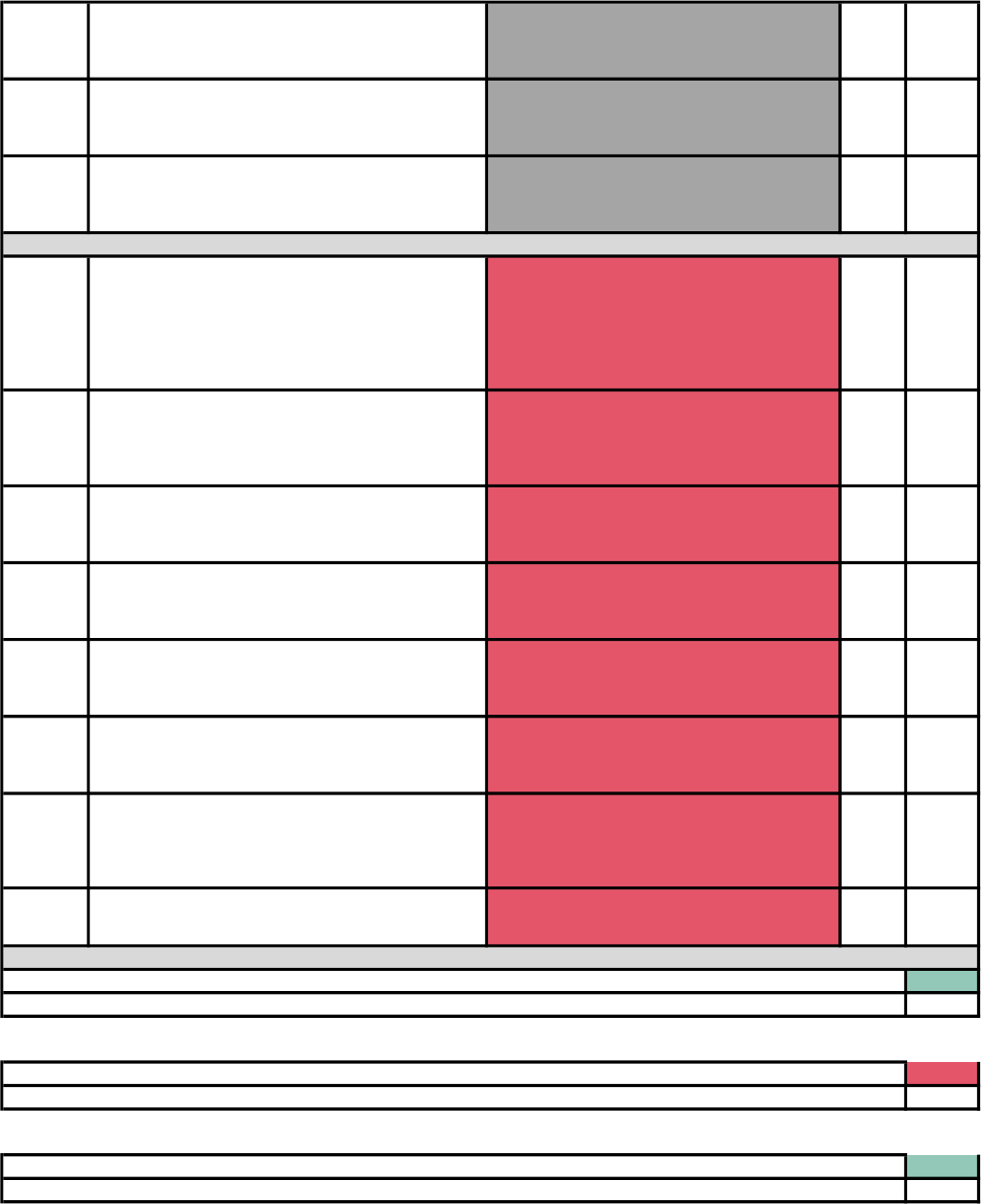
Plastics packaging (household)
N/A (for countries in which a very high share of the
population is already covered by high convenience
collection services)
0.5 0
Plastics packaging (non-household)
N/A (for countries already having mandatory sorting at
source)
0.5 0
Wooden packaging
N/A (for countries already having mandatory sorting at
source)
1 0
P-5.1 Coverage of EPR schemes
Not all main packaging fractions* are covered by EPR
schemes
OR
All main packaging fractions are covered by EPR
schemes but none or only one covers household and
non-household packaging
1 0
P-5.2 Fee modulation in EPR schemes for packaging
No fee modulation OR fee modulation meets less than
two assessment criteria
1 0
P-5.3
Material specific EPR assessment - Paper and cardboard
packaging waste
No EPR scheme or EPR scheme covering only
household, industrial OR commercial packaging
1 0
Material specific EPR assessment - Ferrous metals
packaging waste
No EPR scheme or EPR scheme covering only household
OR non-household packaging
1 0
Material specific EPR assessment - Aluminium packaging
waste
No EPR scheme or EPR scheme covering only household
OR non-household packaging
1 0
Material specific EPR assessment - Glass packaging waste
No EPR scheme or EPR scheme covering only household
OR non-household packaging
1 0
Material specific EPR assessment - Plastics packaging
waste
No EPR scheme or EPR scheme covering only
household, industrial OR commercial packaging OR EPR
scheme but without fee modulation
1 0
Material specific EPR assessment - Wooden packaging
waste
No EPR scheme or EPR scheme covering only industrial
OR commercial packaging
1 0
19.00
32.00
59%
Paper and cardboard recycling target
14.00
30.00
47%
Ferrous metals packaging recycling target
20.00
30.00
67%
Maximum score
Extended producer responsibility (EPR) and similar schemes
Total packaging recycling target
Total score
Maximum score
Total score
Maximum score
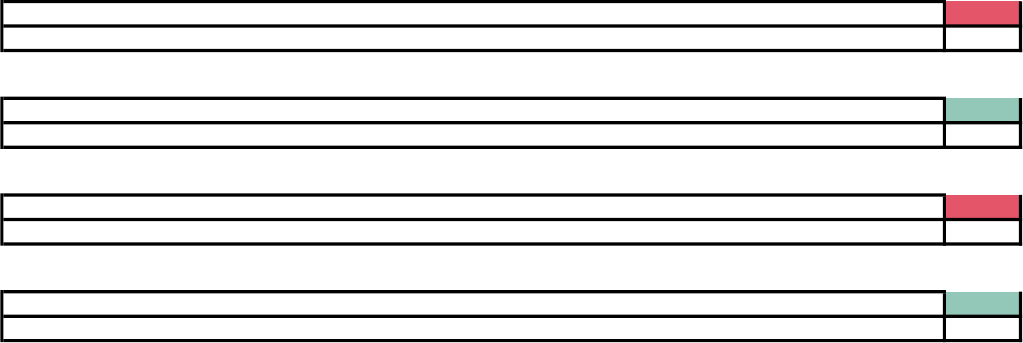
Aluminium packaging recycling target
14.00
32.00
44%
Glass packaging recycling target
20.00
32.00
63%
Plastics packaging recycling target
14.00
34.00
41%
Wooden packaging recycling target
20.00
32.00
63%
Total score
Total score
Maximum score
Maximum score
Total score
Maximum score
Total score
Maximum score
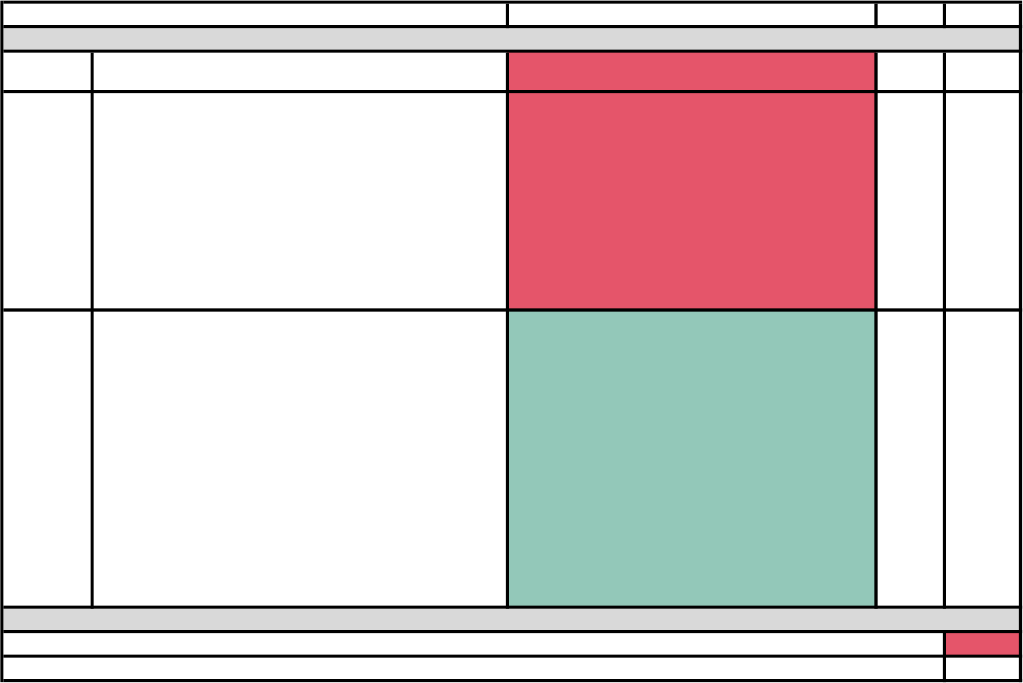
Assessment sheet - Target for landfilling of municipal waste
MS Spain
Date Jun-22
Assessment result Weight Score
LF-1.1 Distance to target
Distance to target > 20 percentage points, or no data
reported
5 0
LF-1.2 Past trends in municipal solid waste landfill rat
Landfill rate in 2020 > 25% and decrease in last 5 years
< 15 percentage points
1 0
LF-1.3 Diversion of biodegradable municipal waste from landfill
Target for reducing the amount of biodegradable
municipal waste (BMW) landfilled to 35% of BMW
generated in 1995 has been achieved in 2016 or in the
year specified in the derogation where applicable
1 2
2.00
14.00
14%
Total score
Maximum score
SRF
Current situation and past trends
